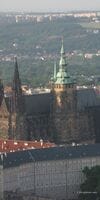Prague Castle (Pražský hrad) is a castle in Prague, a majestic symbol and pearl of the Czech Republic, which is one of the largest castle complexes in the world, founded back in the 9th century.
Prague Castle is a complex consisting of four courtyards, the main street, former palaces, auxiliary and residential buildings, a basilica, a picturesque Golden Street and the dominant of Prague Castle - St. Vitus Cathedral with a high tower, in which there is an observation deck. The complex is surrounded by former fortifications - walls with towers and gates, which are adjacent to gardens with some buildings.
Today, permanent expositions and temporary exhibitions are held in the premises of the Prague Castle.
Prague Castle is located on the eastern part of the long cliff, in the historical district of Prague - Hradčany.
Panoramic view of Prague Castle and its dominant - St. Vitus Cathedral from the observation deck Petrshinskaya Tower (Petřínská rozhledna)
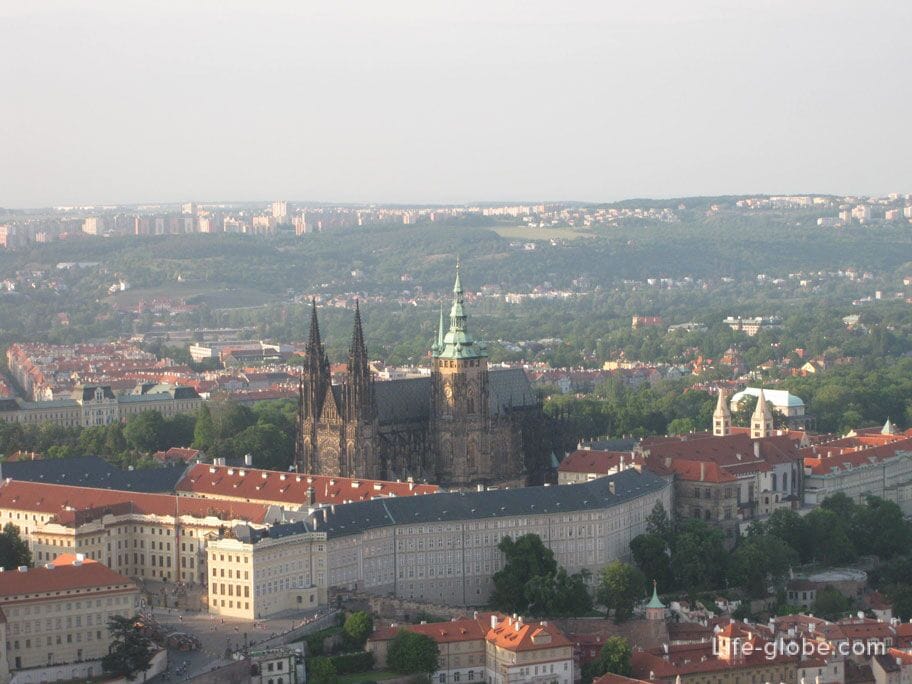
View of Prague Castle and the surrounding ensemble from the Stare Mesto area (Staré Město, Old Town) near Charles Bridge
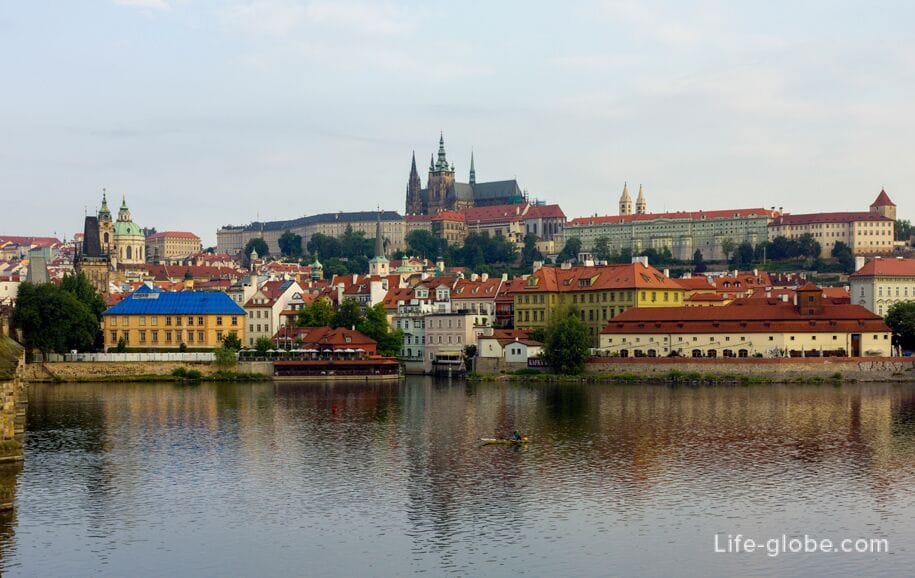
Prague Castle with an earthen rampart was founded in the 9th century, and since the middle of the 11th century it has been fortified with stone walls.
During the history of Prague Castle was rebuilt, improved and expanded. The castle was the residence of Czech princes and kings, Holy Roman emperors, and since 1918 presidents of the Czech Republic.
In the exterior and interior of the buildings, Prague Castle has incorporated elements and styles of different eras: Romanesque, Gothic, Renaissance, Baroque, classicism.
Today Prague Castle is a national cultural and historical monument of the Czech Republic, as well as the residence of the President of the country. Prague Castle can be visited by anyone.
The western part of Prague Castle consists of the former imperial palace and palace buildings located around three courtyards, where St. Vitus Cathedral and St. George's Basilica are also located. In the eastern part of the castle complex there are two originally aristocratic palaces, former residential buildings, a burgraviate and preserved parts of medieval fortifications, including towers. The southern side of the castle is surrounded by gardens. Prague Castle also includes the territories behind the moat on the north side, where there is a Royal Garden with a summer estate and a Lumbe Garden with an adjacent riding school.
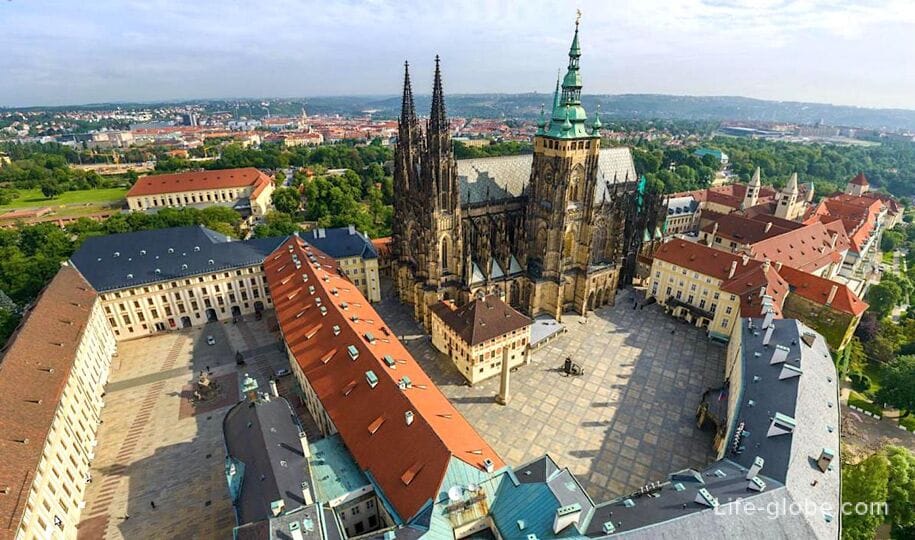
The main front gate leading to the territory of Prague Castle faces the Hradčanské Square (Hradčanské náměstí) and are called the Gate of Giants or the Gate of Titans (Brána gigant?).
The gate was erected in 1850 and has a height of about 25 meters. Baroque figures of Tinans are placed on the powerful pillars of the gate. Today the sculptures are copies, and the originals were the work of Ignaz Frantisek Platzer 1761-1762. The pillars are complemented by an elegant lattice with gilded inserts and figures, and the main entrance is made in the form of a majestic arch.
The entrance to Prague Castle is guarded by an Honor Guard (Hradní stráž) - a special unit of the Armed Forces of the Czech Republic, which carries out guard duty in the Prague Castle fortress. Every day, every full hour (from 9.00 to 18.00), the guard of honor is changed, and exactly at noon in the first courtyard of Prague Castle you can see the solemn ceremony of changing the Guard of Honor with the accompaniment of the orchestra and the exchange of standards.
In addition to the gate of the Titans, the Guard of Honor is also located at the eastern gate (at the Black Tower / Černá věž) and the northern gate, to which the Powder Bridge leads (Prašný most).
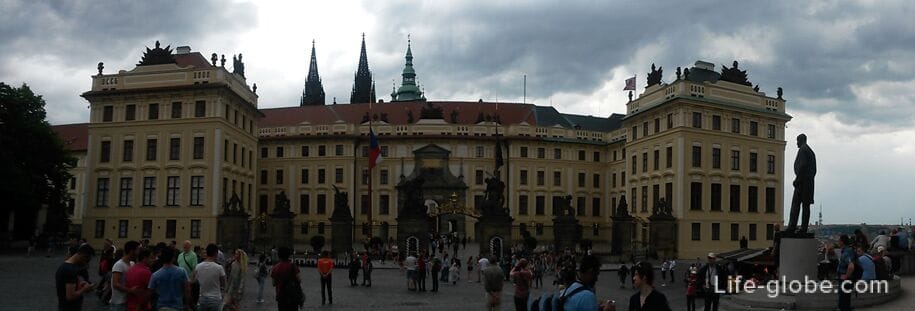
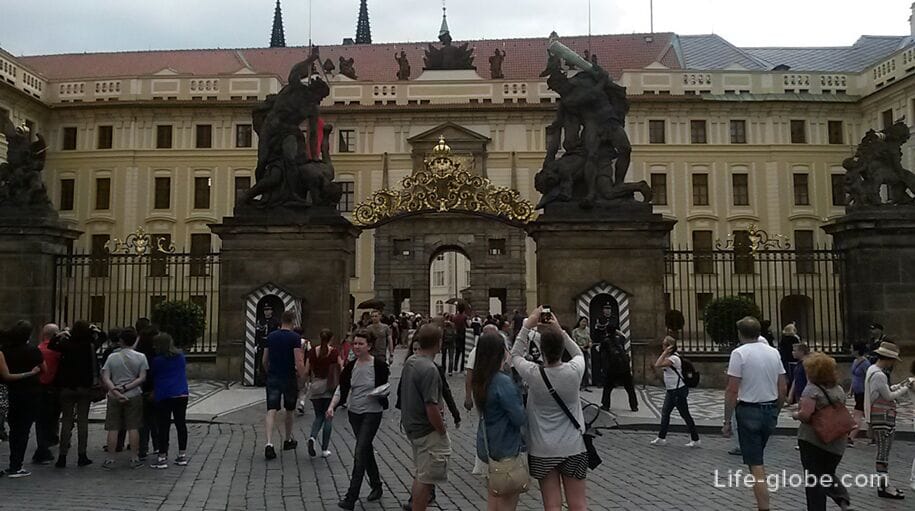
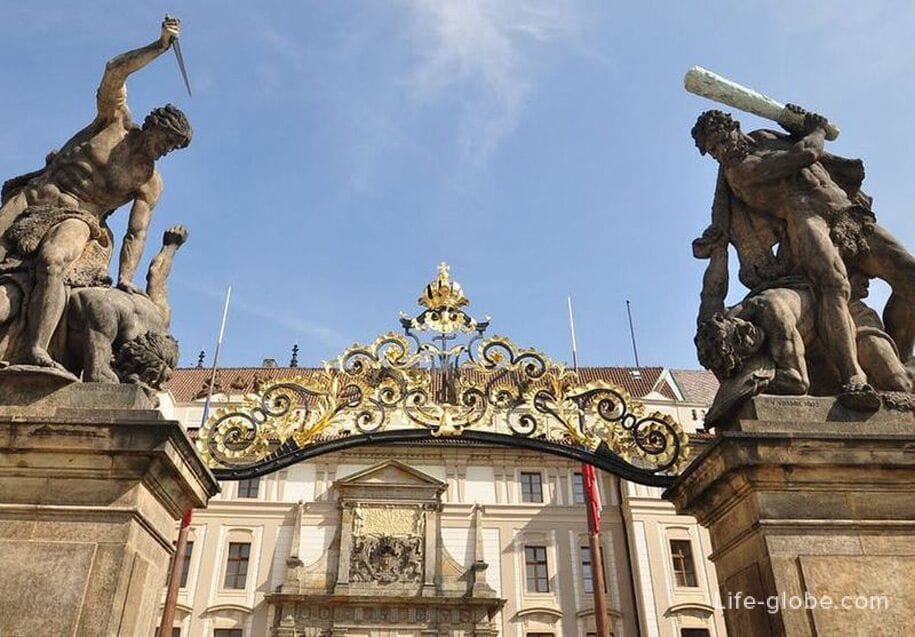
Beyond the gates of the Titans is the first courtyard of Prague Castle (První nádvoří Pražského hradu), which is the front yard of honor.
From the first courtyard to the second are the monumental entrance gates of Matias (Matyášova brána), which have a Baroque style and were erected in 1614, during the reign of Emperor Matthias I, hence the name of the gate. But, most likely, the main part of the gate was built under Emperor Rudolf II, and only the Baroque decoration was added under Matthias.
The architect of the gate is the Italian Giovanni Maria Filippi.
The gate is an ornate single antique triumphal arch with a large travel arch and two smaller entrances on the sides.
In the upper part of the gate there are obelisks, the heraldic coat of arms and the titles of the emperor Matthias, and below, under the cornice - the coats of arms of the countries subject to Matthias.
Two large staircases, which start from the arch of the gate, lead to the premises of the West Wing of Prague Castle.
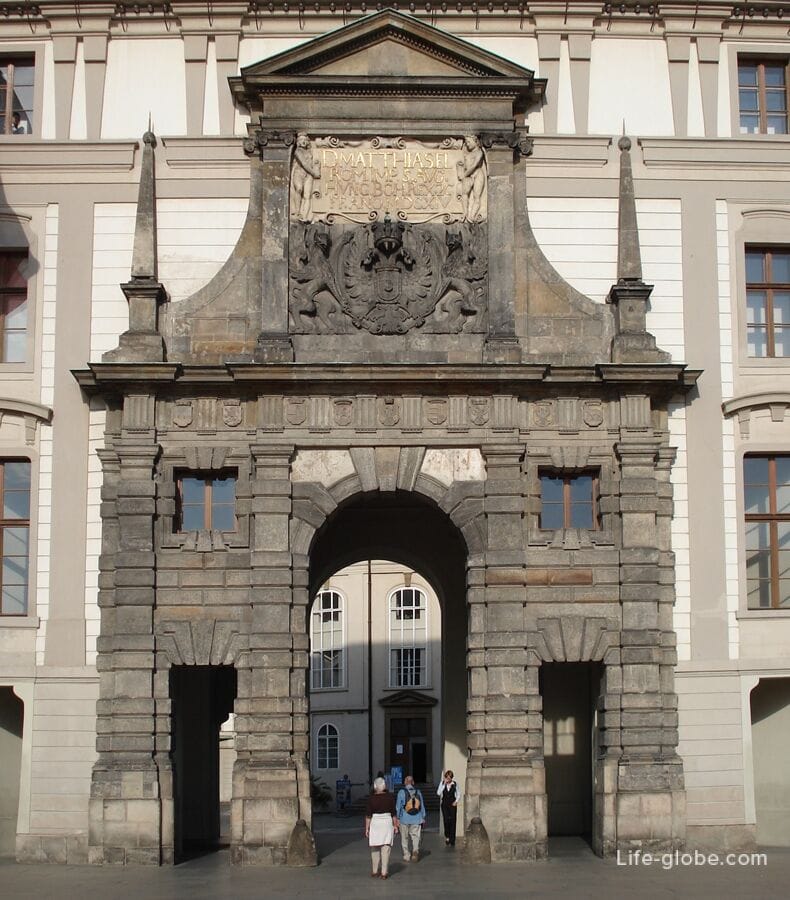

The gates of Matias lead to the second courtyard of Prague Castle (Druhé nádvoří Pražského hradu).
Here is the so-called Theresian wing of the Prague Castle - The New Royal Palace (Nový královský palác) is an expression often used for a set of buildings in the western part of Prague Castle, externally united under Empress Maria Theresa under a single facade. Thus, the appearance of the buildings was unified in 1753-1775 by the Viennese architect Nicolo Pacassi.

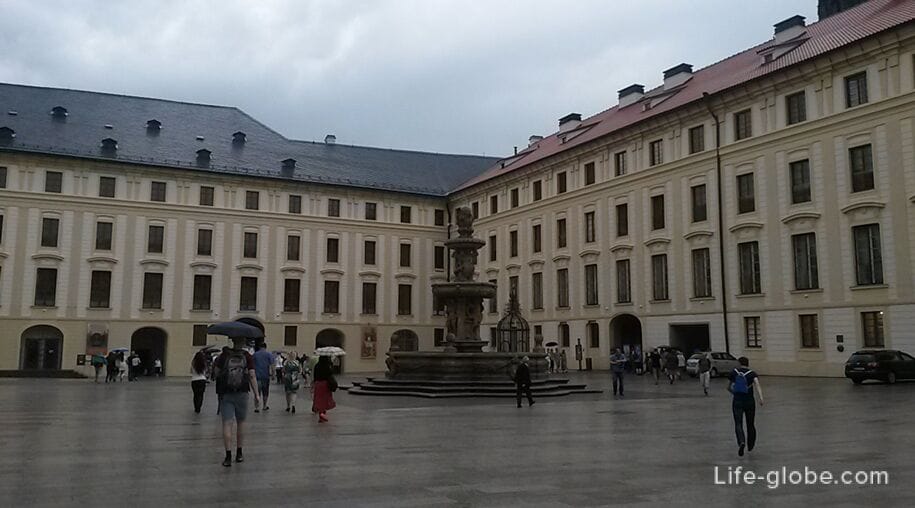
The center of the second courtyard of Prague Castle is decorated with a Renaissance well of the early 18th century with a decorative lattice and a Baroque fountain Kohl (Kohlova kašna), which, because of the sculpture of a lion, is also called the Lion Fountain or Leopold Fountain, in honor of Emperor Leopold I, since the fountain was created during his reign.
The fountain dates back to 1686, and its authors are the sculptor Jerome Kohl, in whose honor the fountain bears its official name.
The fountain is decorated with figures of lions, ancient gods (Mercury, Vulcan, Neptune and Hercules), tritons, festoons, lion heads, mascarons and cartouches with the imperial monogram "L" (Leopold I). Previously, there was an imperial double-headed eagle on the fountain sphere, but after 1918 it was removed.
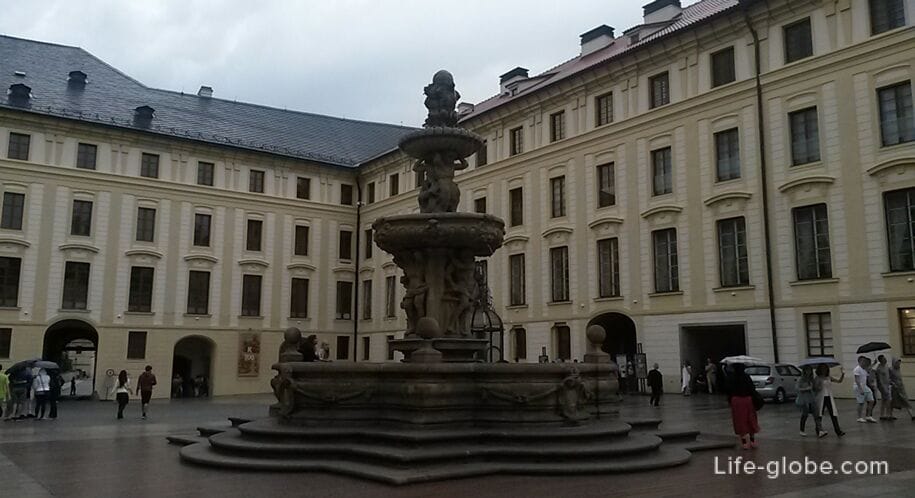
In the rooms around the courtyard are located:
- representative spaces of the President of the Czech Republic, which are available for visits only on open days.
Here the President of the Republic receives foreign guests, appoints ministers, judges and generals, organizes state dinners, gala concerts or other cultural events.
The most important representative spaces of the New Royal Palace are: the Pakassi Staircase, the Pillared Hall, the Rotmayer Hall, the Spanish Hall, the Music Room, the Throne Room, the Brozhik Salon, the Habsburg Salon, the Glass Salon, the Mirror Salon, etc.;
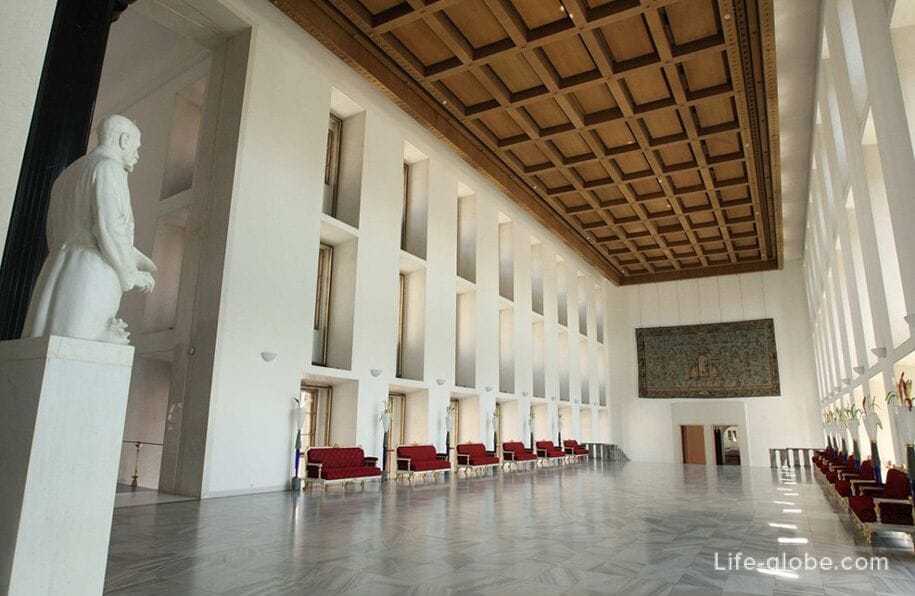
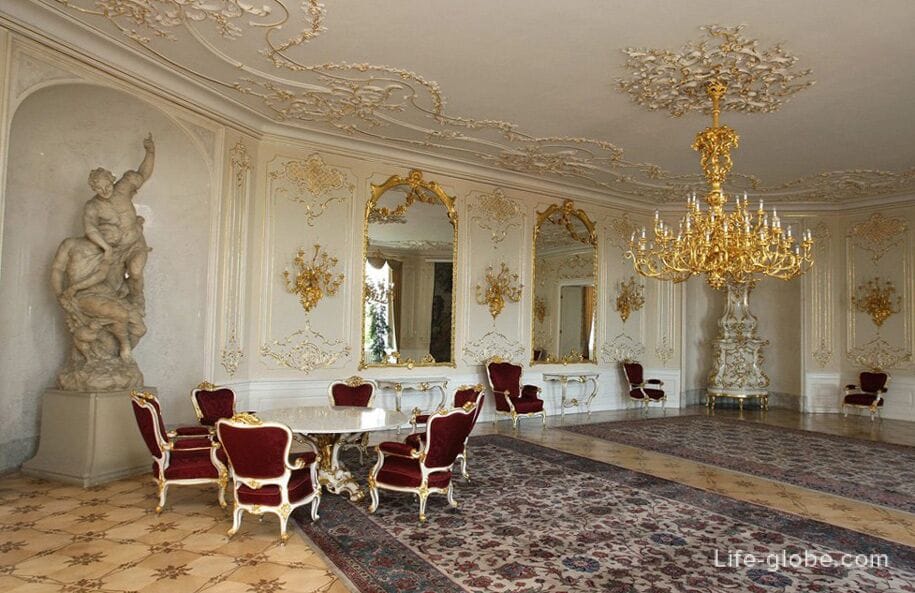
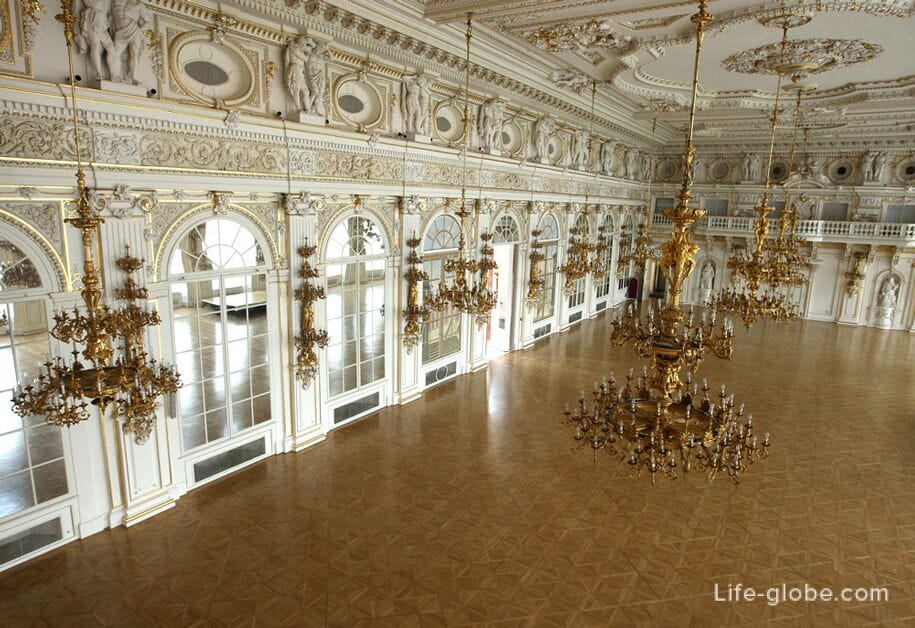

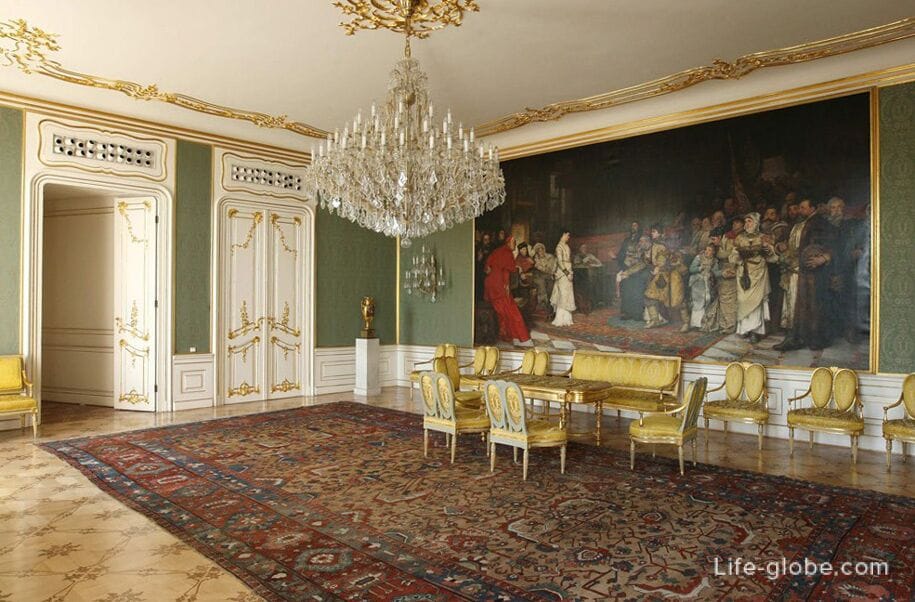

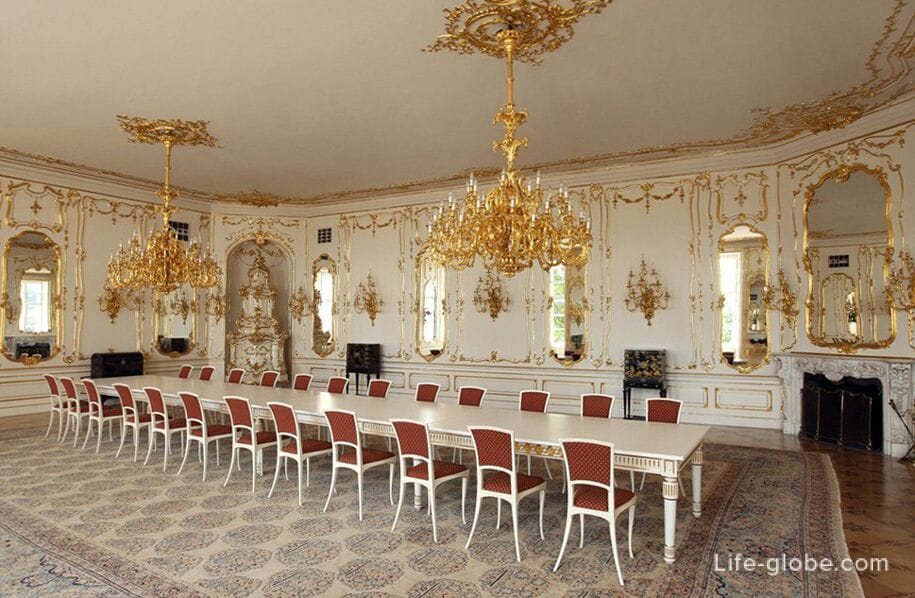
- The Prague Castle Art Gallery (Obrazárna Pražského hradu), located in the former imperial stables of Emperor Rudolf II and partly in the adjacent wing.
This is the oldest permanent collection of paintings in the Czech Republic, dating from the end of the 16th century. The permanent exhibition presents to visitors a representative selection of more than a hundred paintings of the highest quality and several sculptures from the property of Prague Castle.
A visit to the Prague Castle Art Gallery is paid;
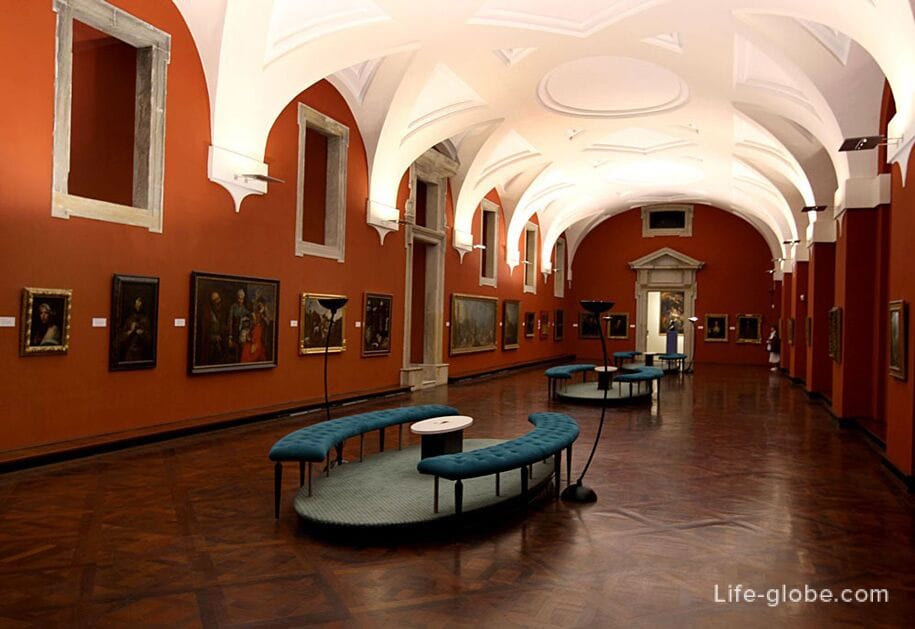
- exhibition space in the former imperial stables, which were originally built by Rudolf II around 1583 on the site of part of the fortress walls.
Currently, short-term exhibitions are held here.
The entrance fee varies depending on the type and scale of the exhibition;
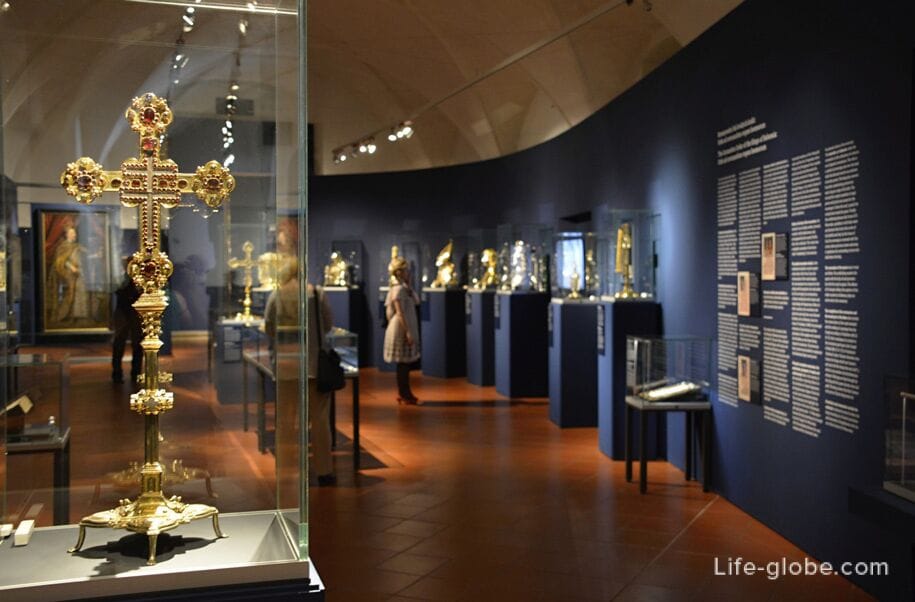
- Chapel of the Holy Cross (Kaple svatého Kříže), projecting into the courtyard with an interior in the late Baroque style.
The chapel was built in 1758-1763 by the Prague builder of Italian origin Anselm Martin Lurazh according to the project of N. Pakassi. In the middle of the 19th century, the chapel was rebuilt in the classical style.
The chapel is decorated with statues of Saints Peter and Paul by Emanuel Max from 1854, as well as frescoes by Josef Navratil and Wilem Kandler from the 1950s on the themes of the Old and New Testaments. On the main marble altar by Josef Lauermann there are statues of angels by Ignaz Frantisek Platzer and a large painting "Crucifixion" by the artist Frantisek Xavier Balko.
The chapel's decoration is dominated by the life-size altarpiece of Christ on the cross, created in 1762 by František A. Palko.
From time to time, cultural events take place in the chapel. The church treasures exhibited here until 2020 were returned to St. Vitus Cathedral.

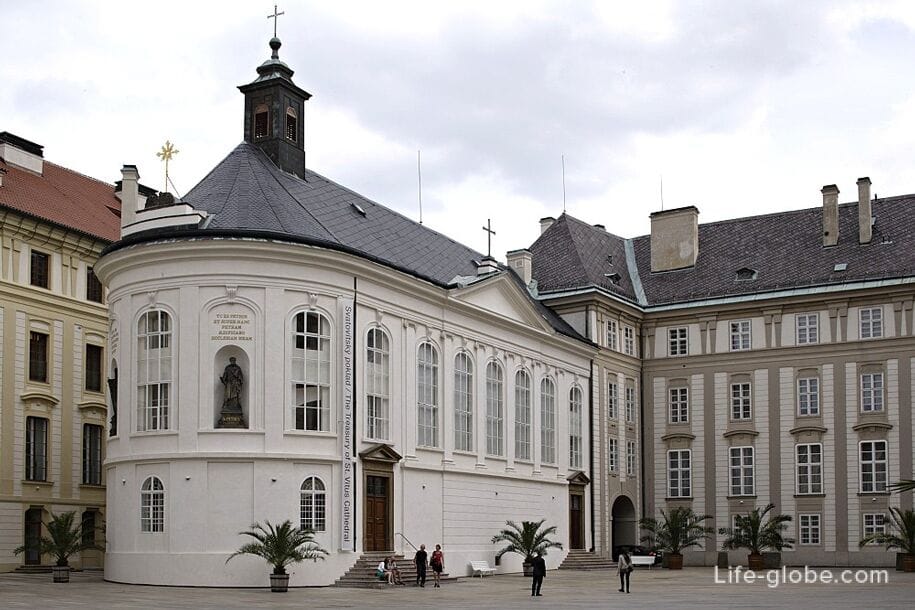
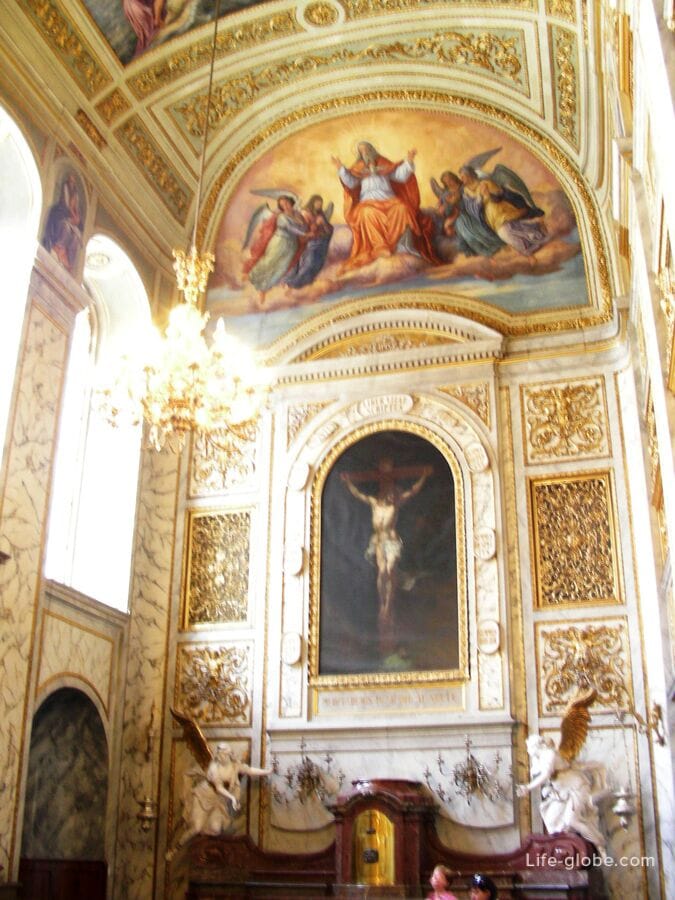
From the second courtyard, through the passage, you can go to the main and largest - the third courtyard of Prague Castle (Třetí nádvoří Pražského hradu).
The dominant feature of the third courtyard is the Cathedral of St. Vitus (Katedrála St. Víta), which is an example of Gothic architecture, as well as the largest and most important church in the Czech Republic.
The full name of the cathedral: The Cathedral of Saints Vitus, Wenceslaus and Vojtech / Albrecht (Katedrála svatého Víta, Václava a Vojtěcha).
There are free and paid parts in the cathedral for visits. There are also services and excursions and you can visit the gallery of the South Tower of the Cathedral, which offers a panoramic view of Prague (a visit to the observation deck is paid).
In the cathedral there is a treasury and tombs, including St. Wenceslaus, the Przemysl, Jan Nepomuk, Przemysl Otakar I and Przemysl Otakar II, Maximilian II, Ferdinand I and his wife Anna Jagiellon. More about St. Vitus Cathedral...

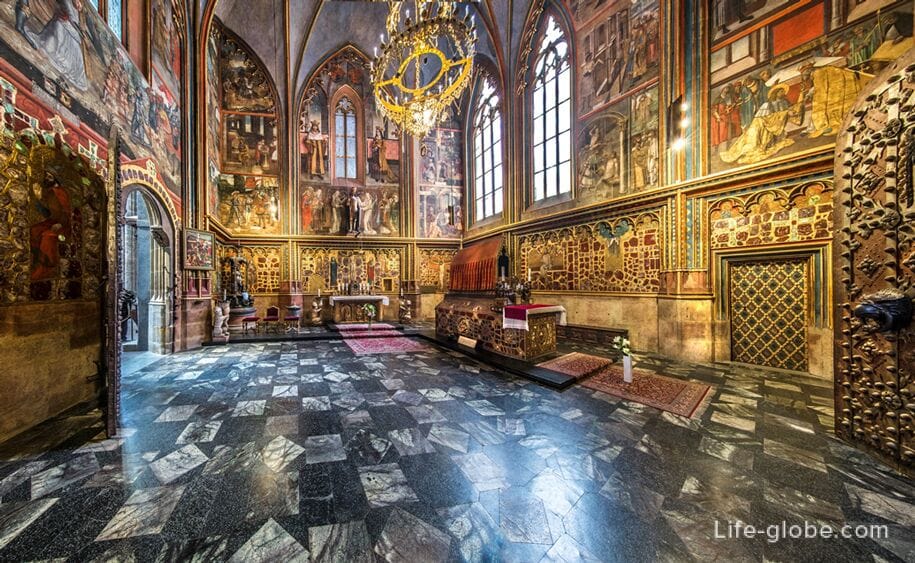
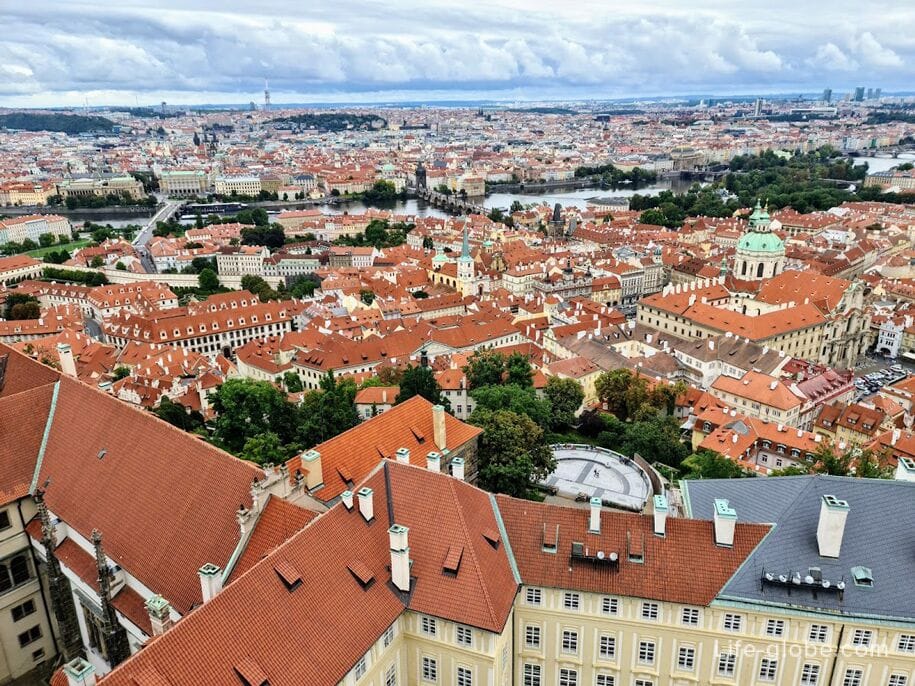
The second dominant of the yard isThe Old Royal Palace (Starý královský palác), which served as the residence of Czech princes and kings from the 10th to the 16th centuries.
In the palace: the executive floor with the famous late Gothic Vladislavsky Hall (Vladislavsky sál), Ludvik's wing (Ludvíkova křídla) with rooms and premises, the Theresia wing (Tereziánské křídlo) with exhibitions, the Church of All Saints (Kostel Všech svatých), the Romanesque dungeon and the Gothic floor with the exposition "The History of Prague Castle".
The old Royal Palace can be visited. More about the Old Royal Palace...

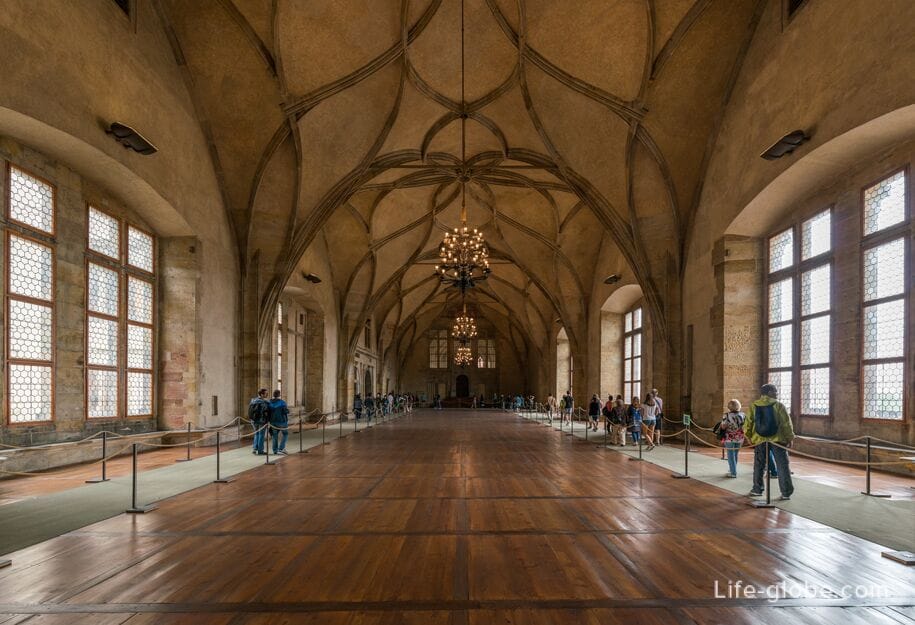
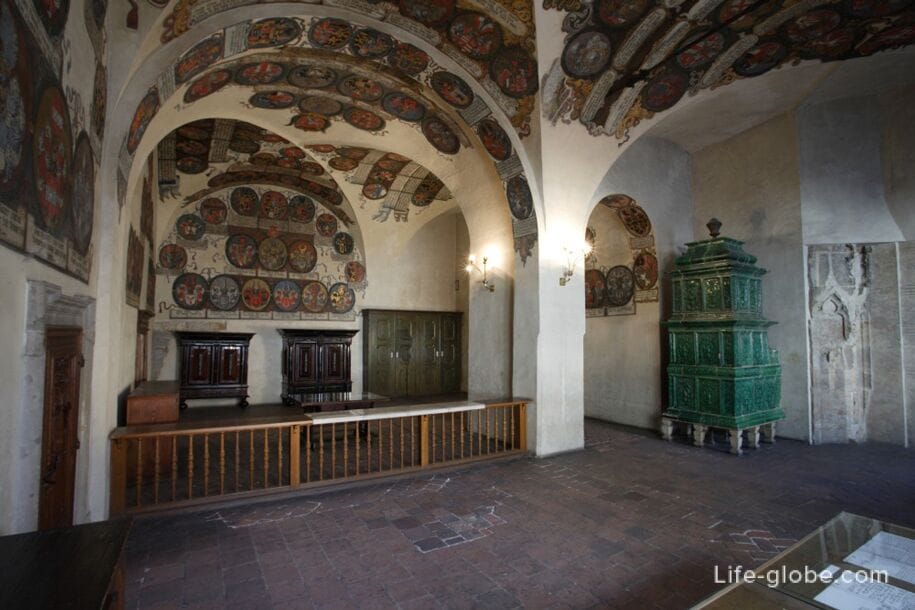
Also in the second courtyard of the Prague Castle there are:
- Archive of Prague Castle (Archiv Pražského hradu), apartment and office of the President of the Republic (Kancelář prezidenta republiky) with the presidential balcony of the 18th century, sculpted by the workshop of Ignak Platzer. It once paid homage to the monarch.
The building is part of the New Royal Palace;

- the old Bishop's House (Staré proboštství, the rector's office) is a Baroque building located next to St. Vitus Cathedral.
The building was created as a result of the reconstruction in the middle of the 17th century of the original Romanesque bishop's house of the first half of the 11th century.
Above the entrance to the building is the coat of arms of Rector Jan Frantisek from Aschenfeld, who rebuilt the building in the Baroque style. On the southwest corner there is a sandstone statue of St. Wenceslaus by Jan Jiri Bendl from 1662, and on the southern facade there is a memorial plaque designed by architect Pavel Yanak dedicated to the victims of the Nazi occupation;

- equestrian monument of St. George (Socha svatého Jiří) on a high pedestal, depicting St. George as a horseman, a knight in plate armor and with a spear, sitting astride a frisky steed and striking a dragon.
The sculpture was cast in 1373 by the brothers Martin and Jiri from Kluge, as recorded in the reports of the Prague Castle. But who made the original is still the subject of professional discussions among art historians. It could have been a sculptor from Prague, Transylvania or Hungary (according to Hungarian records).
Today it is one of the most important Czech Gothic bronze statues.
Currently, in the third courtyard there is a bronze replica of the statue of the 1970s;
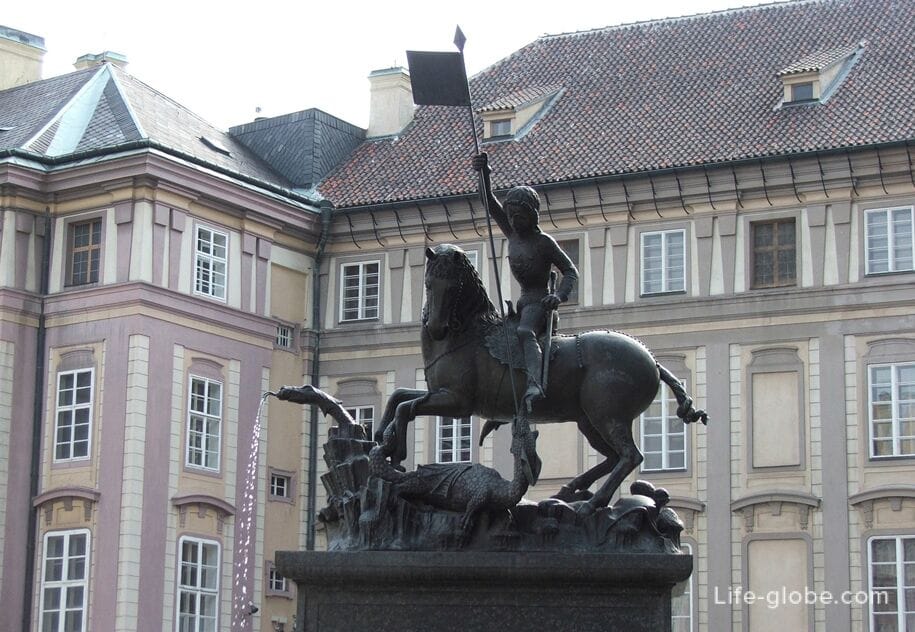
- obelisk in Prague Castle or monolith Mrakotin (Obelisk na Pražském hradě, Mrákotínský monolit), which is a tall rectangular monolithic truncated pyramid, opened on the occasion of the 10th anniversary of Czechoslovakia in 1928.
The obelisk was created as a monument to the fallen during the First World War. The author of the obelisk is Slovenian architect Josip Plechnik, and the initiator and sponsor is the first President of Czechoslovakia Tomas Garrig Masaryk.
At the time of installation in Prague Castle, the obelisk was not fully completed - its upper part was missing, which was added before 1996 on the initiative of Czech President Vaclav Havel;
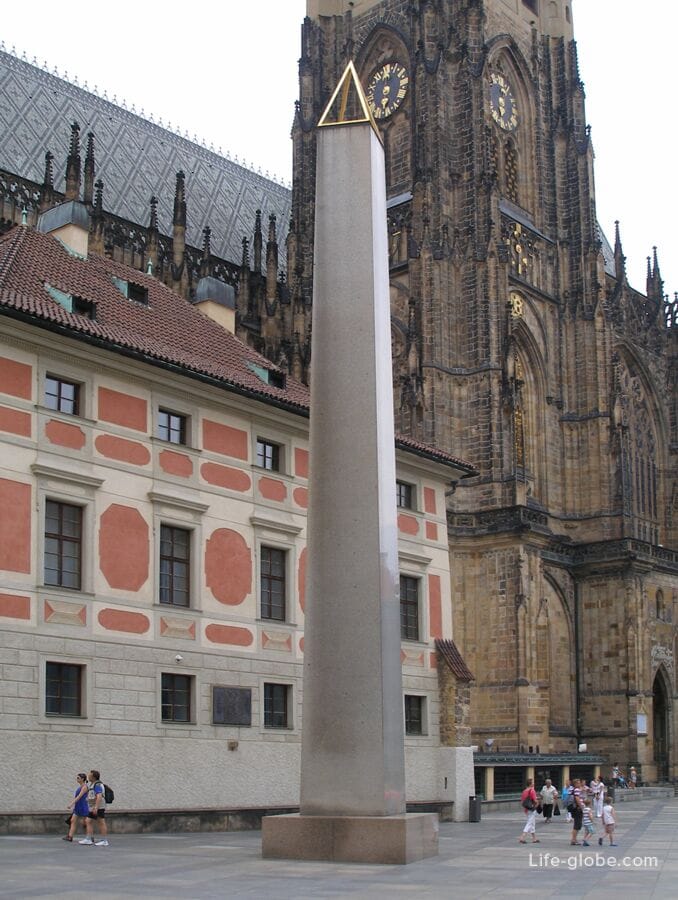
- fountain "Eagle" or the Eagle Fountain (Orlí kašna), located at the entrance to the Old Royal Palace. The fountain was created in 1662 by the sculptor Francesco Caratti.
Part of the fountain is below the level of the surrounding landscape. Part of the fountain's pool is now located on St. George's Square in Prague Castle.
The bronze column of the fountain was decorated with dolphins, which were stolen and replaced with an eagle, which, in turn, was replaced with a copper ball with lead nozzles. The ball on the column can still be seen today.

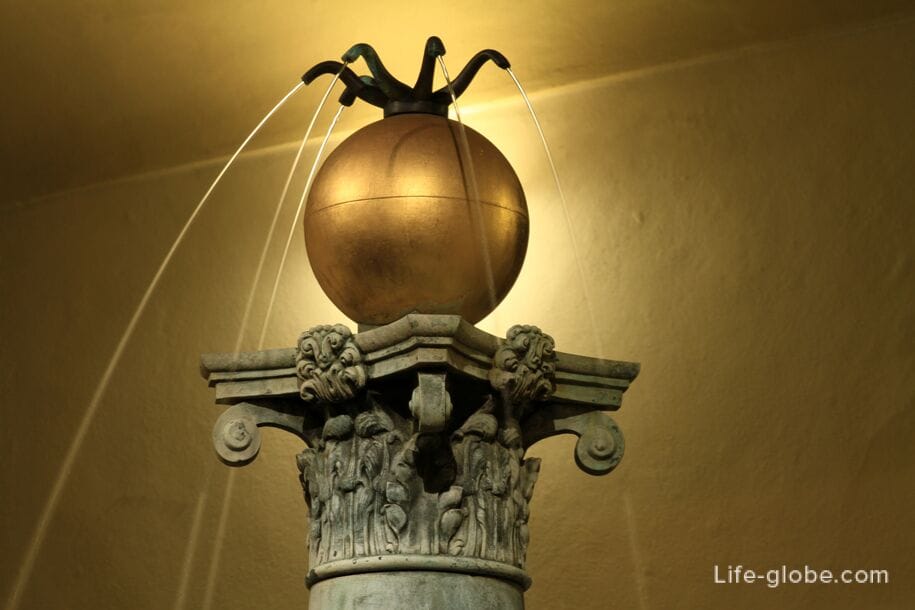
On the north side along the Cathedral of St. Vitus stretches Vikarzhska Street (Vikářská), which got its name from the Vicars (priests) who were housed in houses along the street.
The most striking building of the street is the Dean's office of the chapters (Kapitulní děkanství), similar to a small palace. Also located here are: the foundry yard, smaller houses-vikarki and the former school of the chapter.
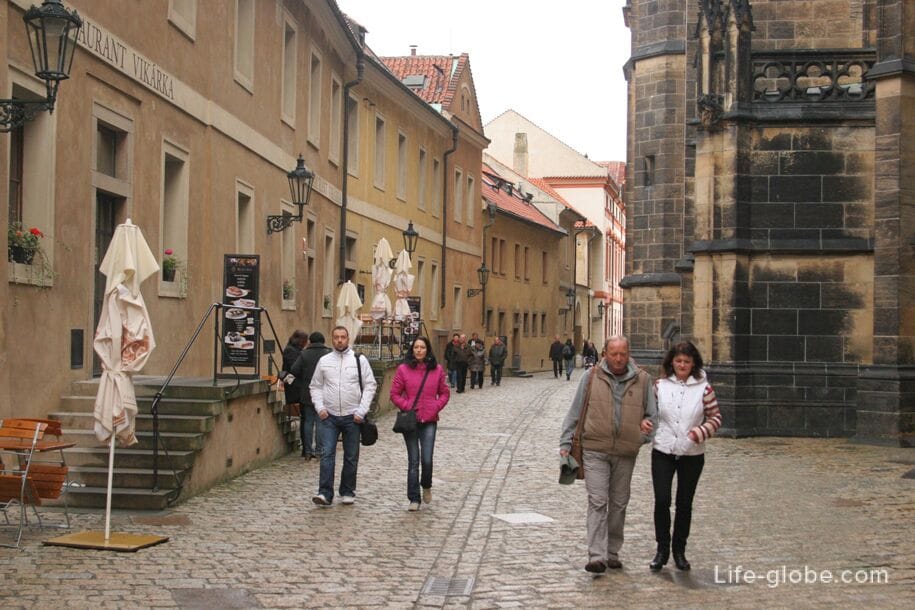
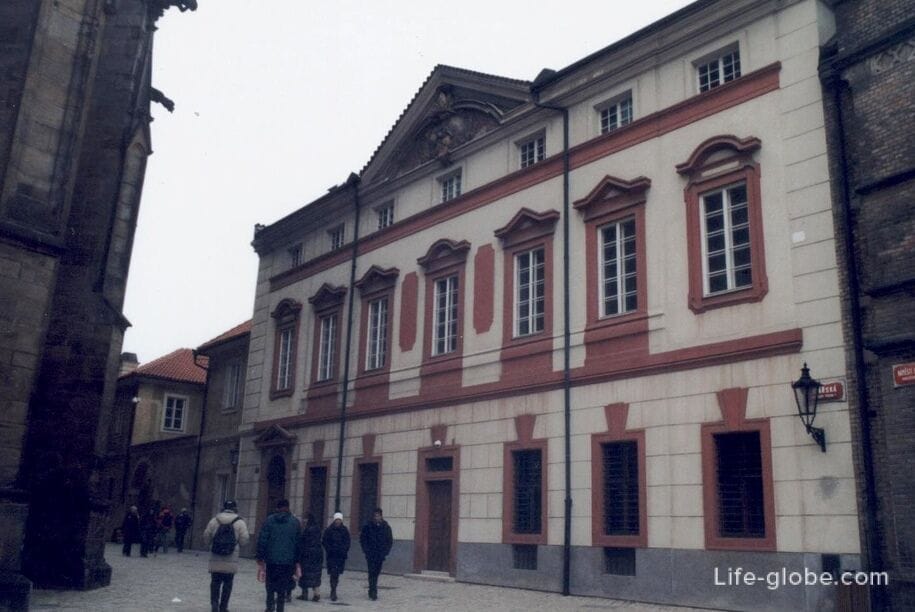
Behind the Vicars ' houses standsThe powder tower of Migulka (Prašná věž Mihulka), which was part of the northern defensive fortifications of the castle complex of Prague Castle.
The tower with a height of 27.4 meters was built in the second half of the 15th century according to the project of Benedict Reith and was the most massive and important of all the defensive towers of the castle in terms of its firepower. In 1522 it was built on a low floor. On four floors of the tower there were loopholes for firing guns of different calibers, and in the basement there were five artillery pieces.
During the reign of Rudolf II, the tower housed an alchemical workshop. After the great fire of the castle in 1541, the tower was rebuilt, and it housed the workshop of the locksmith Tomas Yarosh. Later, there was a powder magazine in Migulka, so the tower is also called the Powder Tower. During the explosion of gunpowder during the invasion of the Swedish army in 1649, the tower was severely damaged. It served as a warehouse until 1754. Subsequently, and up to the 20th century, the churchmen of St. Vitus Cathedral were housed in the tower.
Today, the tower houses an exhibition dedicated to the castle guard.
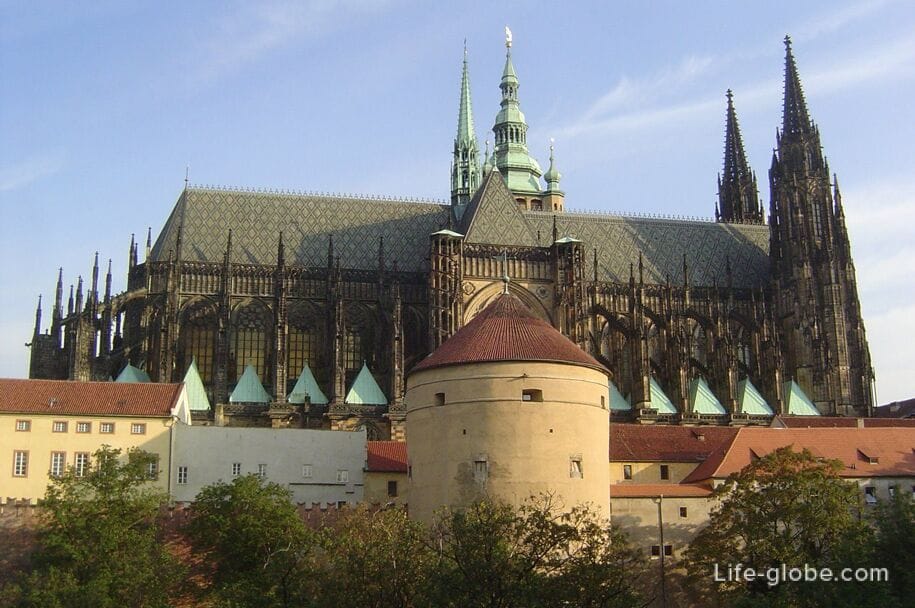

Behind the Cathedral of St. Vitus stretches the Square of St. George or St. George's Square (Girzhskaya Square, Náměstí U Svatého Jiří).
The center of the square is decorated with part of the Carrati Fountain - the second reservoir of which is now part of the Eagle Fountain. The fountain originally had the famous Gothic statue of St. George.
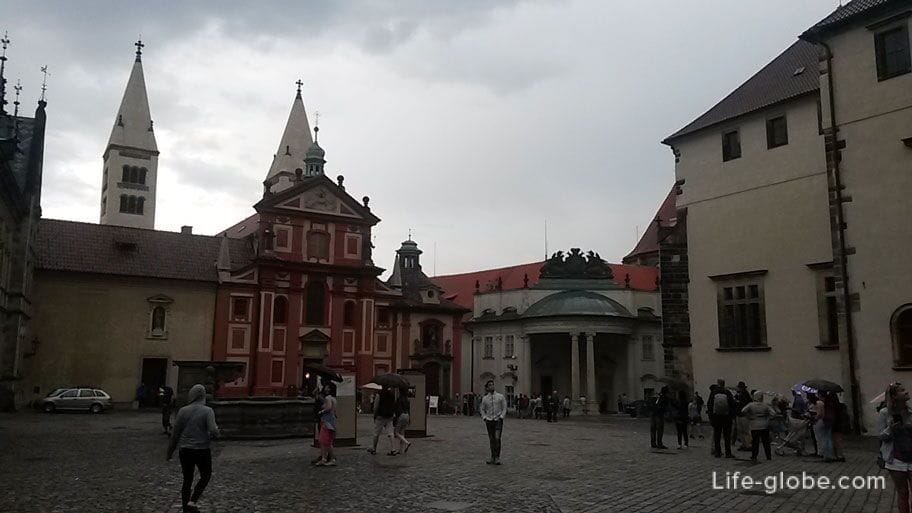
The main dominant of the square is the Basilica of St. George (Bazilika svateho Jiří) with the monastery of the same name, which is the oldest Czech church and the burial ground of the first Czech princely and royal dynasty of the Przemyslovichs in Prague.
The church was originally founded around 920 by Prince Wrocław I . Only the foundation of this church has been preserved.
The current appearance of the basilica is due to the reconstruction carried out in 1887-1908 by the architect Františka Mach.
The appearance of the basilica is dominated by two towers of white marl and two rows of Romanesque windows, reaching a height of 41 meters. The wider tower on the south side is called Adam (Adam's), and the narrower and inclined by 40 centimeters is called Eve.
The interior of the basilica is Romanesque, austere and monumental. In the attached chapel of St. Ludmila from the 13th century there are the remains of this first Czech martyr, the grandmother of St. Wenceslaus. There is also a crypt in the basilica.
Short-term exhibitions are held in the premises of the basilica. More about St. George's Basilica...
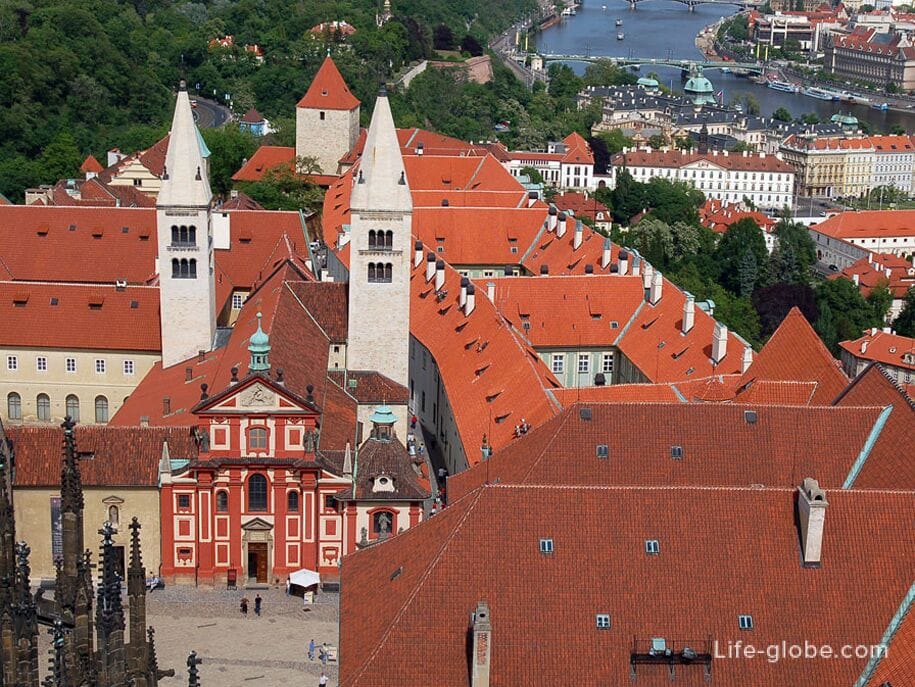

Next to the Basilica of St. George, the corner part of the former Institute of noble maidens, made in the form of a columned pavilion, catches the eye.
In the photo below, a view of the Institute of noble Maidens - on the right and the Basilica of St. George - on the left

Along the perimeter of St. George Square are located: a wing of the Old Royal Palace and a neo-Gothic New priest's house.
A new priest's house (Nové proboštství) was built for the rector of the Chapter of St. Vitus. The construction was carried out in 1877-1888 by Joseph Moker during the completion of St. Vitus Cathedral and on the site of the Renaissance house of the governor of Prague Castle and the house of the abbess of the monastery. This symmetrical building in a strict Gothic style with a pair of pointed risalites is distinguished by an asymmetrical balcony on the left side and a statue of St. Wenceslas by Ludwik Szymek on the corner.
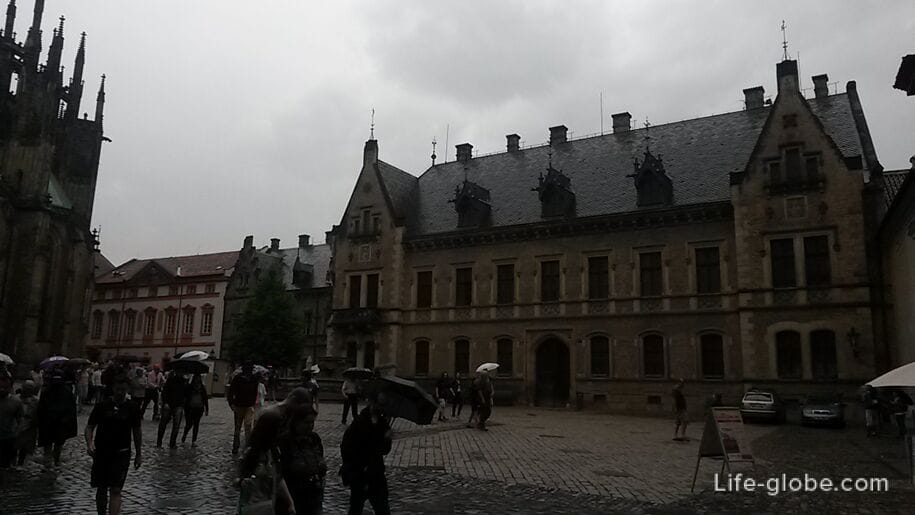
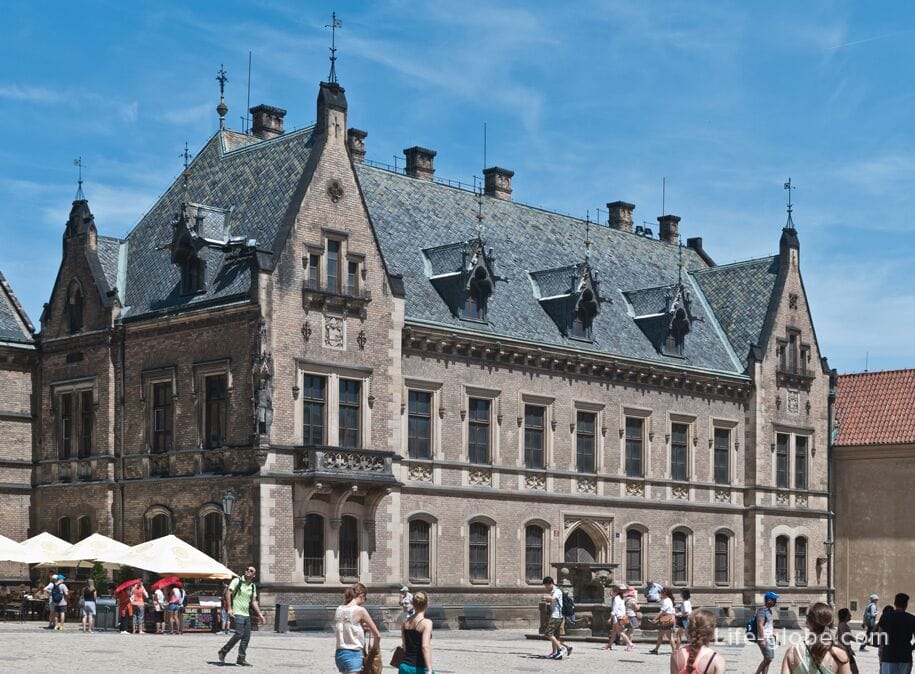
From St. George 's Basilica deep into Prague Castle stretchesGeorgievskaya Street or Jirzhskaya Street (Jirska).
On one side of the street there is the St. George Monastery and historical buildings, where cafes are located today, and on the other side there are former palaces.
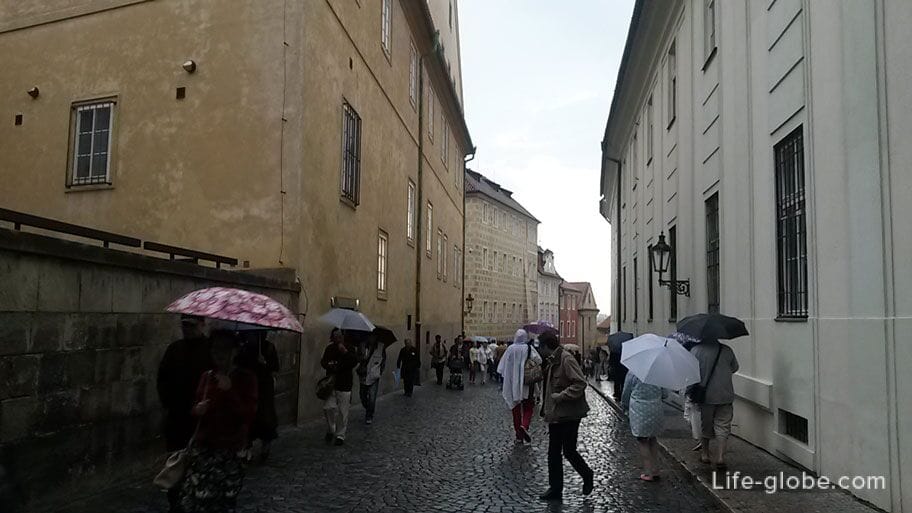
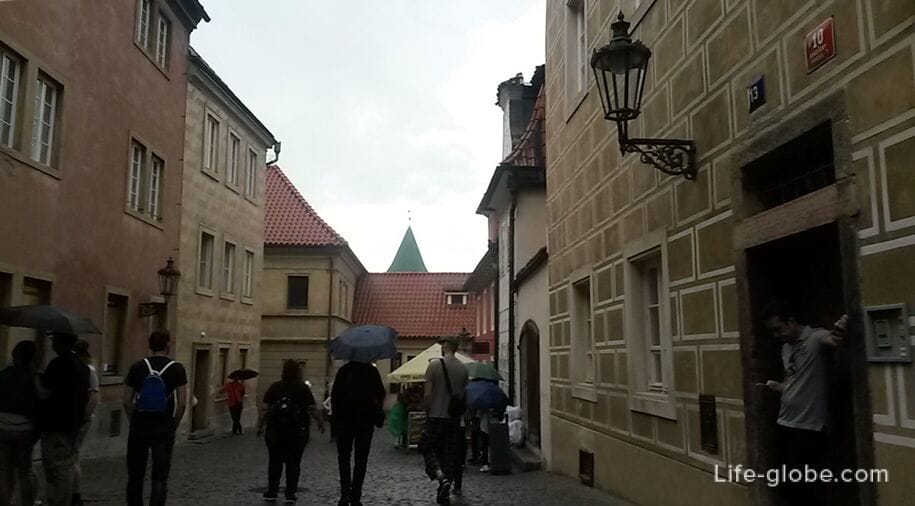

Palaces along St. George Street:
- The Rožmberský palác (Rožmberský palác) Palace is a former Renaissance palace, which housed the Institute of Noble Maidens (Ústav šlechtičen), and today you can visit the recreated interiors. More about the Rozhmberkov Palace...


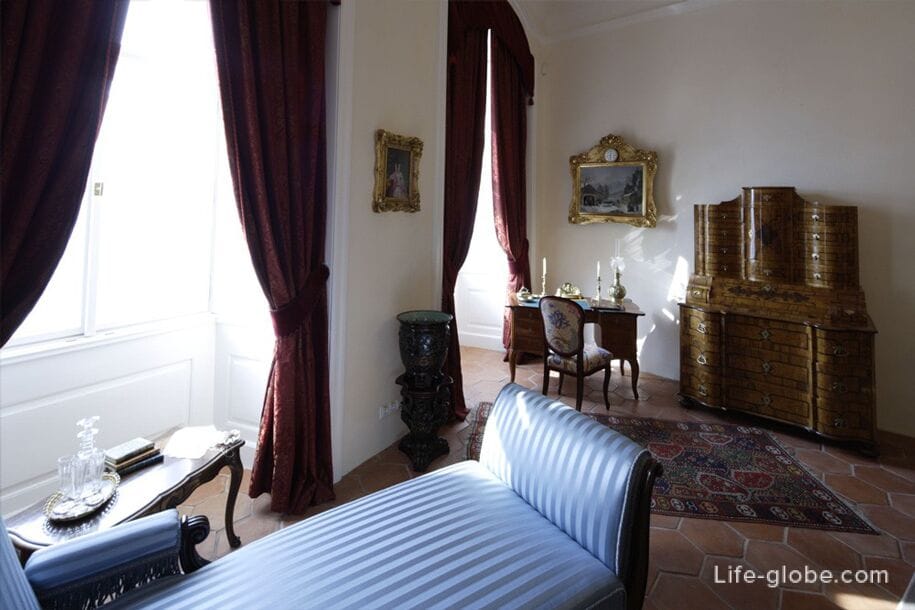
- Lobkowitz Palace or Lobkowicz Palace (Lobkowiczký palác) in Baroque style, which is the only private building in the Prague Castle complex.
Today it is a palace-museum, which presents the most important works and objects of the extensive collection of one of the noble noble families of Bohemia - the Lobkovits.
The 17th-century Baroque Lobkowitz Palace Concert Hall regularly hosts classical music concerts, and the premises are also used for weddings, celebrations and other events.
The terrace of the Lobkovitsky Palace offers panoramic views of the historical part of Prague and the Vltava River.
In addition, you can visit the restaurant in the palace, with tables in the courtyard, on the terrace and in the interior with the appropriate atmosphere. More about the Lobkovitsky Palace...
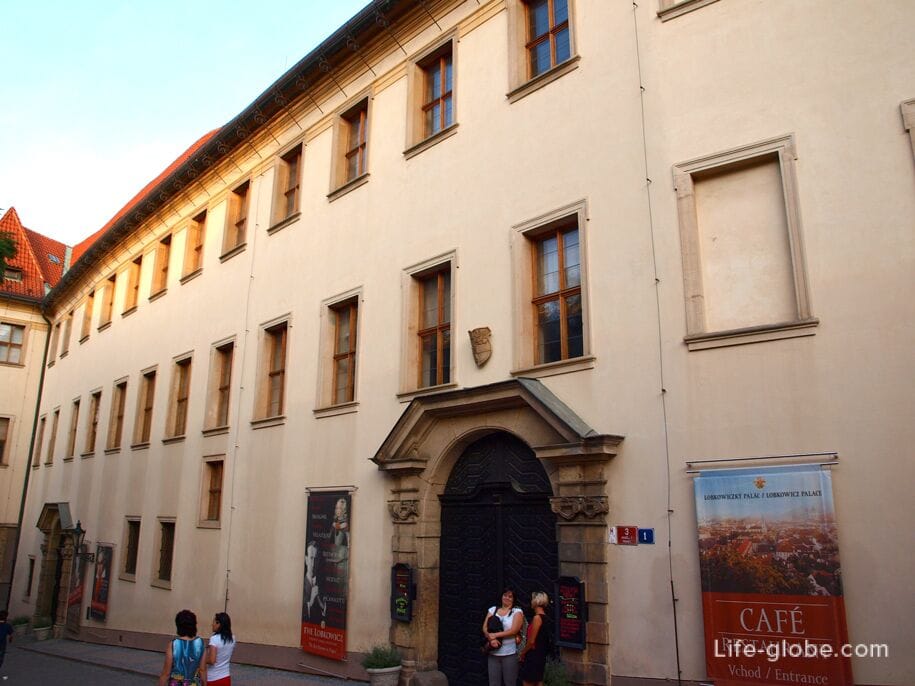
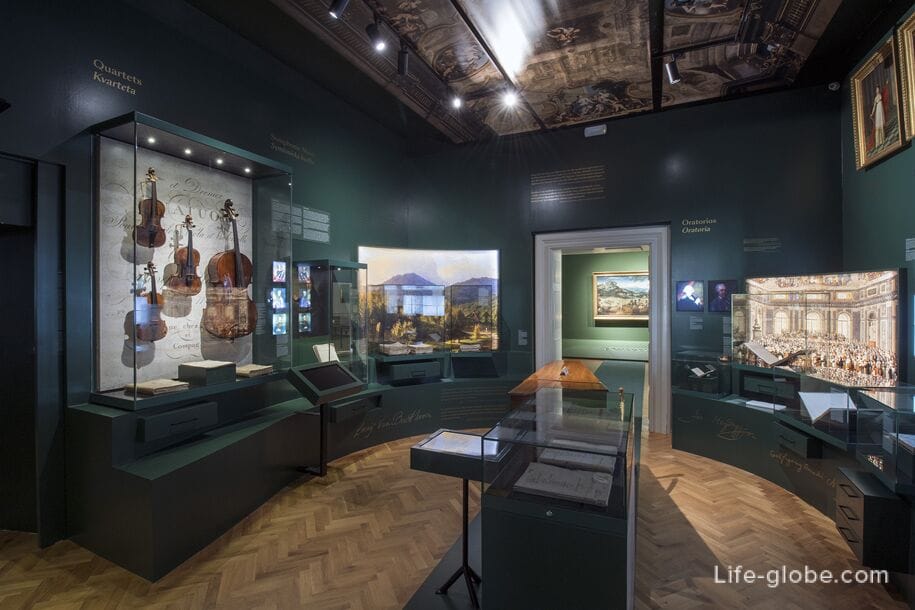
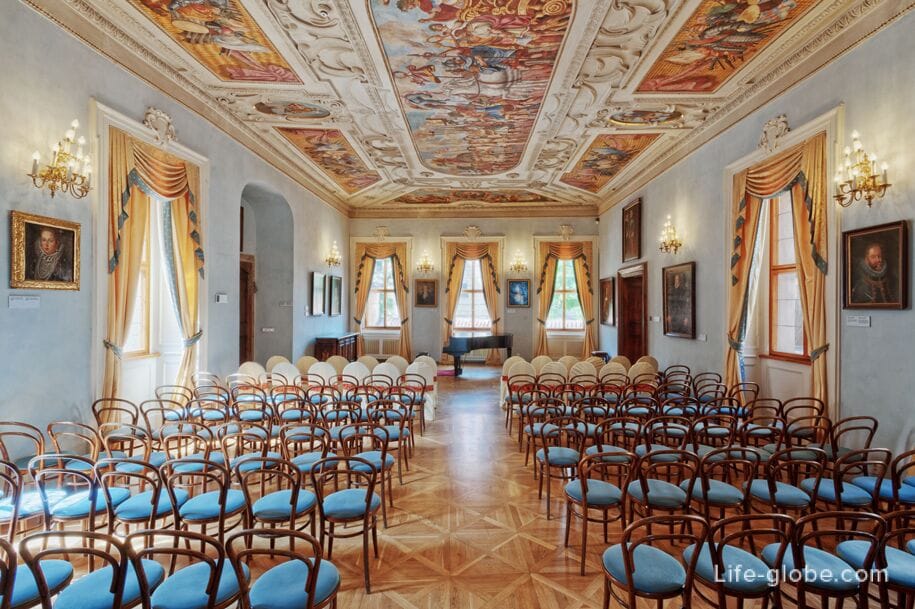

The famous Zolotaya Ulochka (Zlatá ulička / Zlata ulochka) adjoins Georgievskaya Street.
This small paved street is characterized by its appearance with small colorful houses that have a fabulous look and are built into the former fortress wall of Prague Castle.
Once in these small houses on the street lived castle Streltsy, and families of gold minters, from whom the street got its name "Jewelry Street" (Zlatnitska / Zlatnicka).
Some of the houses along the street are souvenir shops, there is a bookstore that is associated with the most famous inhabitant of the street - Franz Kafka, as well as a cafe. While in other houses there are expositions with interiors showing the daily life of local residents over the past five centuries. So, there is a house of a clairvoyant, herbalist, seamstress, movie lover, a tavern and an exposition of knight's armor, weapons and instruments of torture. More about the Golden Street...
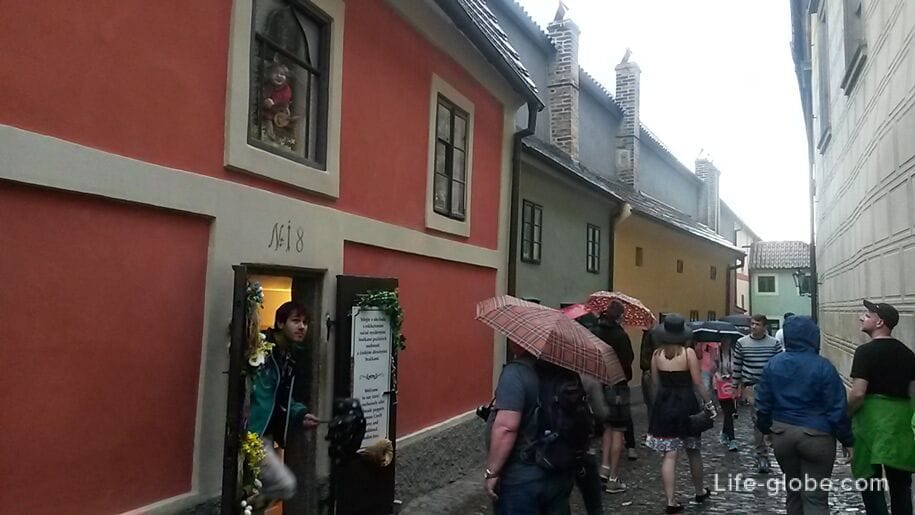
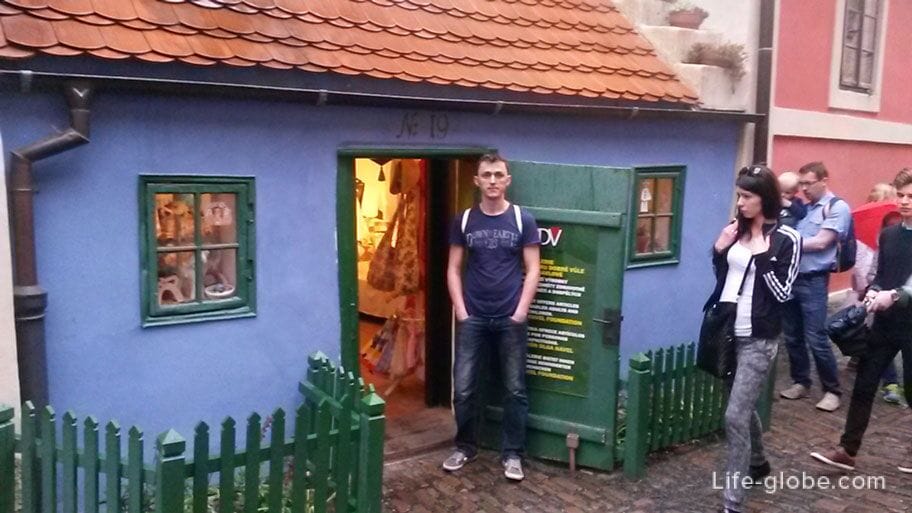

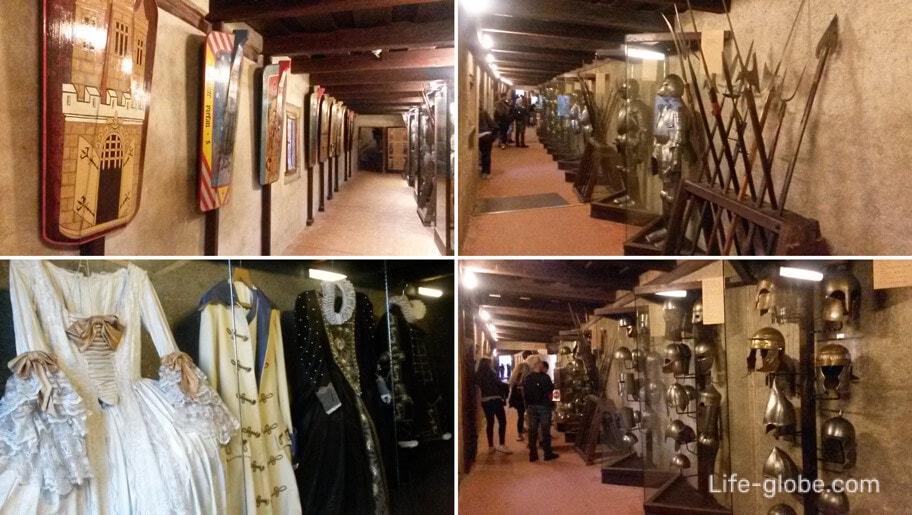
The former defensive corridor leads over the roofs of the houses of Golden Street and is hidden behind stone walls. Today, the empty corridor is hung with knight's armor. The corridor connectsThe White Tower (the tower in the western part of Golden Street) with the Daliborka Tower (the tower in the eastern part of Golden Street).
The towers house expositions.
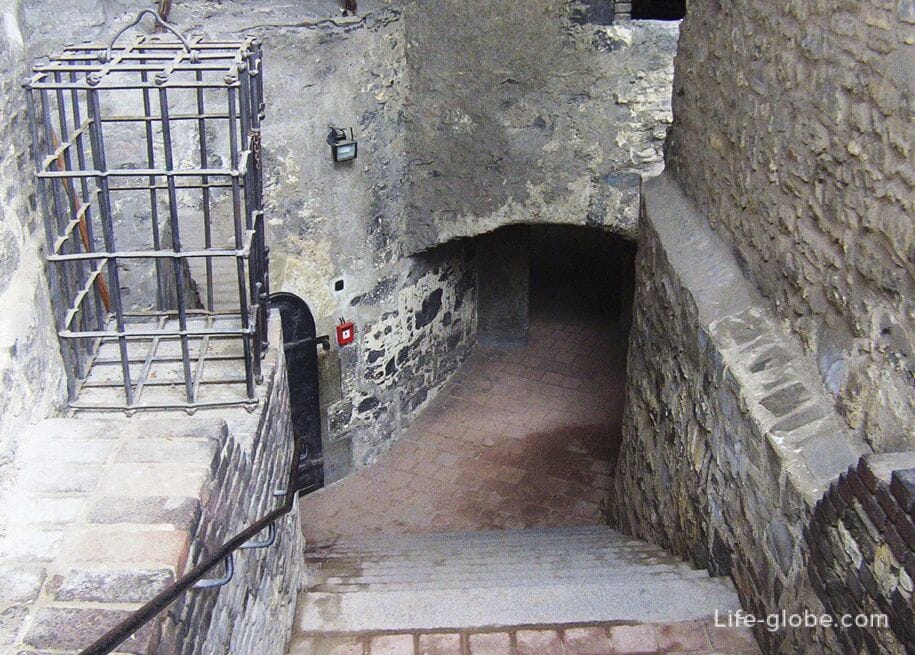
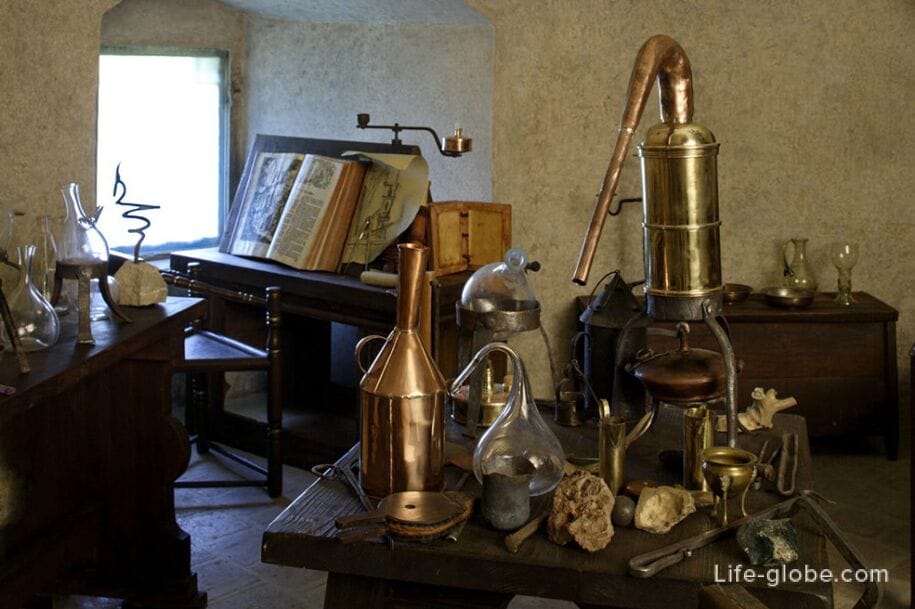
At the eastern edge of Prague Castle isThe Old Burgraviate or the Higher Burgraviate (Staré purkrabství, Nejvyšší purkrabství). It was the residence of the burgraves of Prague Castle.
Burgraves were subordinate to the monarch and had tax, judicial and executive power in their administrative unit. Initially, the burgraviate was called the areas belonging to the most important strategic places (especially castles), where the military garrison subordinate to the burgrave was located. The Burgrave of Prague Castle was the most important provincial official of the Czech Kingdom. This position was held by members of the most important aristocratic families.
The residence of the castellans and later burgraves probably stood in these places already in Roman times. In the 14th century, the Burgrave's house served as the temporary residence of the next king and Emperor Charles IV. After the fire of 1541, the Burgraviate's courtyard was rebuilt in the Renaissance style. During another renovation in the 1960s, some of the original buildings were abolished and replaced with new buildings.
There was also a courtyard in which executions were carried out, and today there is a bronze monument to a naked young man. There are always a lot of people at the monument, and its dignity is polished to a shine. Many tourists consider it their duty to take a picture with a naked young man, while touching his causal place. It is believed that such an action attracts good luck, and helps ladies who have difficulties with conception to get pregnant.
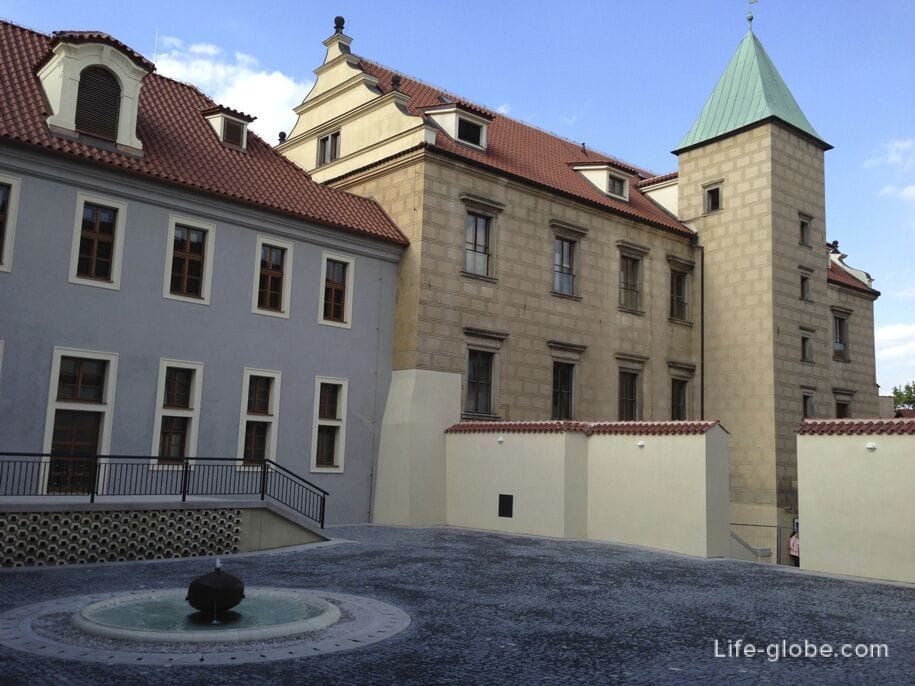
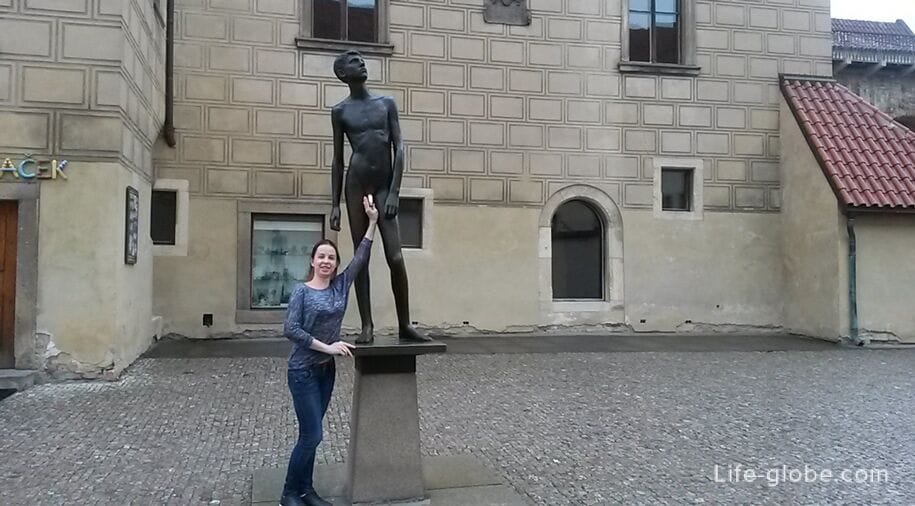
Four family coats of arms of the former burgraves of the 17th and 18th centuries are placed above the gate leading to the courtyard of the burgraviate.

The eastern part of the walls of Prague Castle
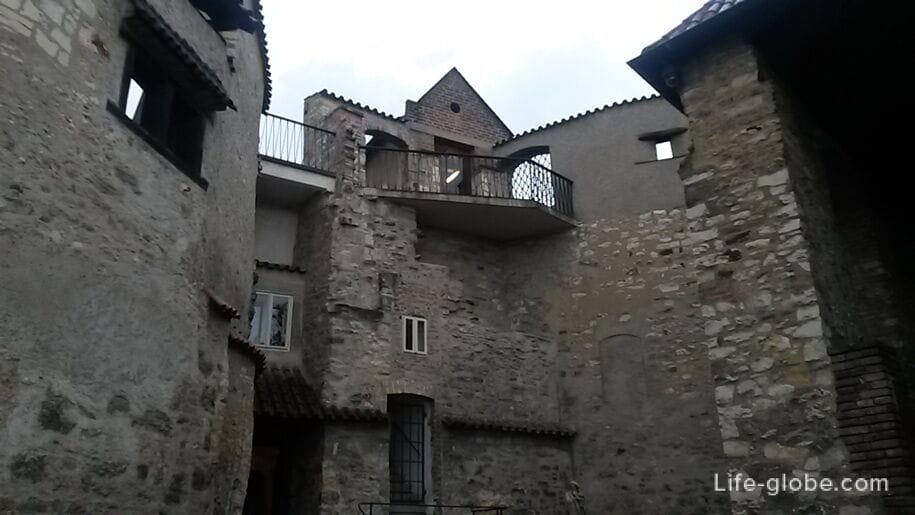

The southeastern edge of the Prague Castle complex is marked by the Black Tower and The eastern gate.
The Black Tower or Golden Tower (Černá věž, Zlatá věž) is a tall four-sided stone tower. Despite the fact that the tower has undergone various changes, it has retained the character of a medieval castle tower of the 12th century. It is the only surviving tower from the original Romanesque fortifications of Prague Castle.
The Black Tower was built as the eastern gate of the Romanesque fortifications, and was also part of the territory of the Burgraviate. The upper floors of the tower served as a prison, especially for debtors.
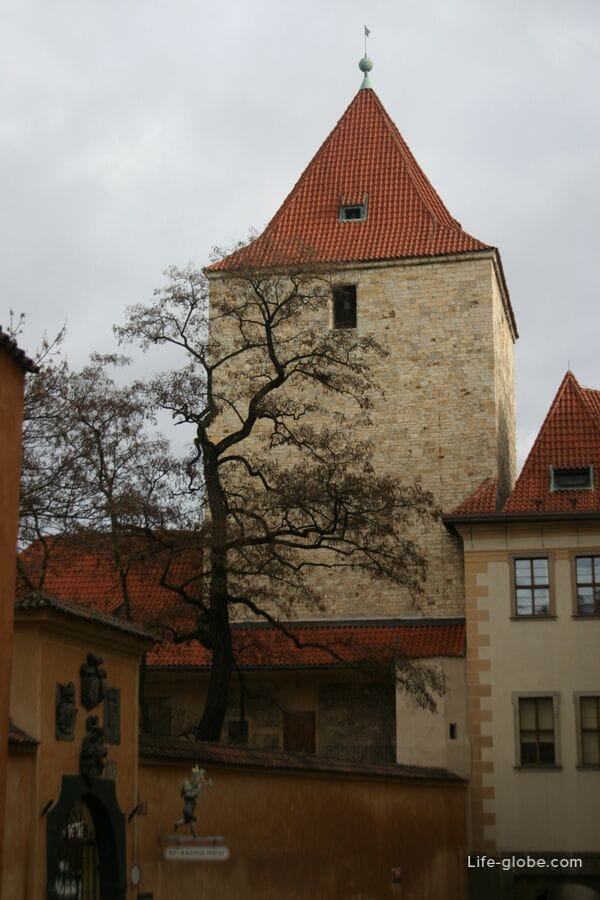

Behind the Eastern Gate there is an observation deck at the Black Tower or an observation deck on the hill of Opyši (Vyhlídkové místo Na Opyši), which offers beautiful views of Prague.

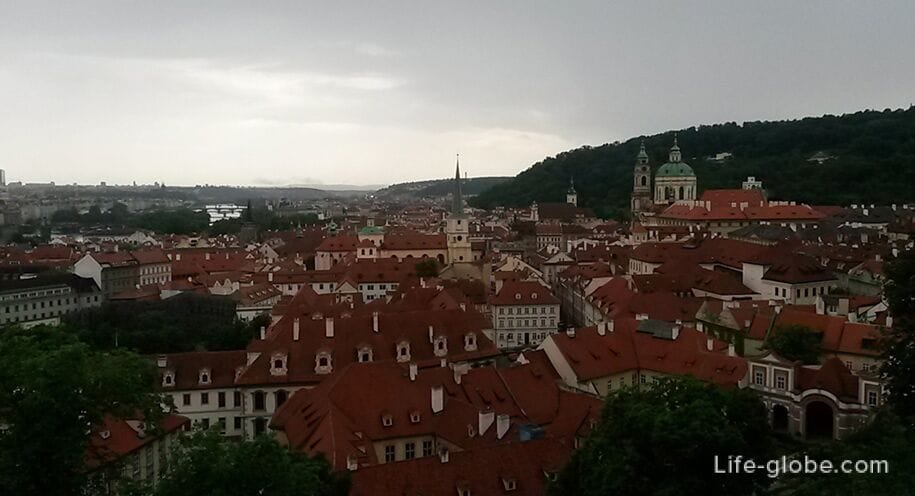
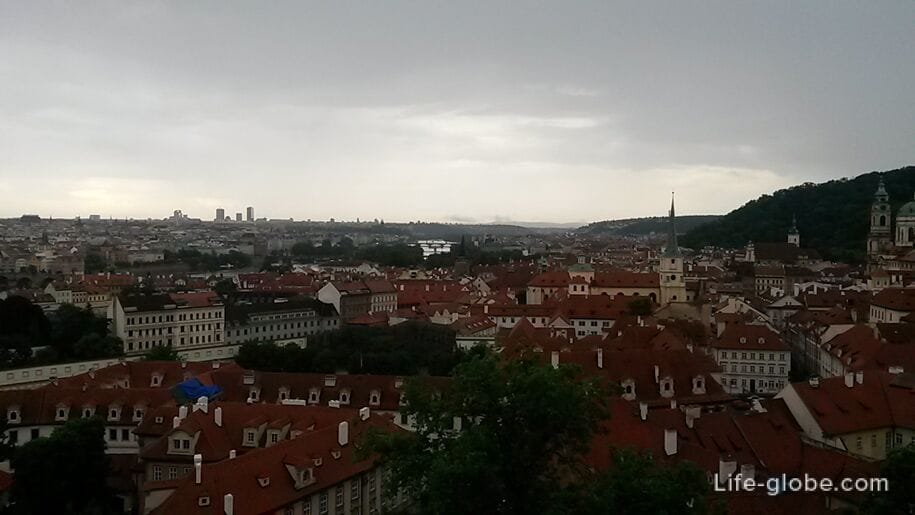

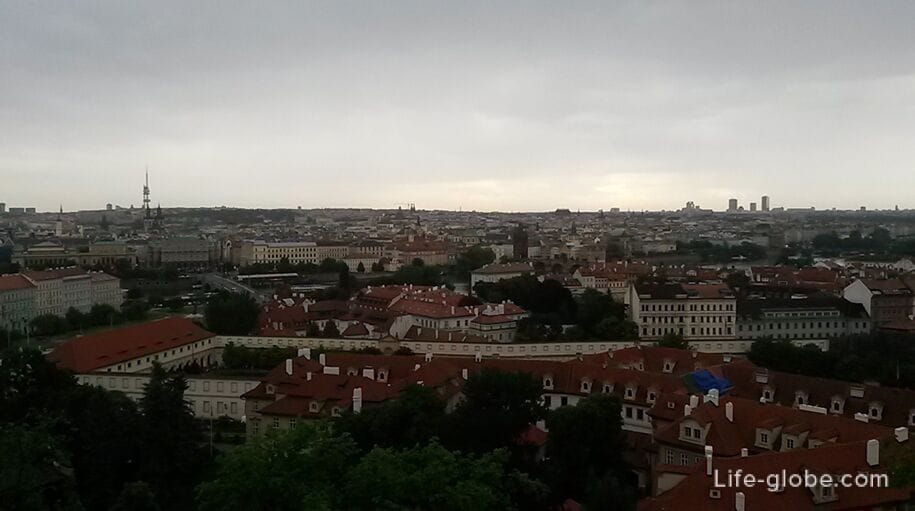
From the East Gate of Prague Castle and the observation deck descendsThe old castle staircase (Stare zamecke schody), which leads to Pod Bruskou Street, to the Malostranska metro station, and connects Prague Castle with the Mala Strana district.
This staircase is a public pedestrian road. It has existed since the 17th century, and its current form dates from 1835-1837.
The staircase is enclosed by a wall, has a length of about 230 meters and consists of 121 steps.
The monument to Czech singer Karel Gashler by sculptor Stanislav Hanzik was installed on the stairs and inaugurated on October 31, 2009.
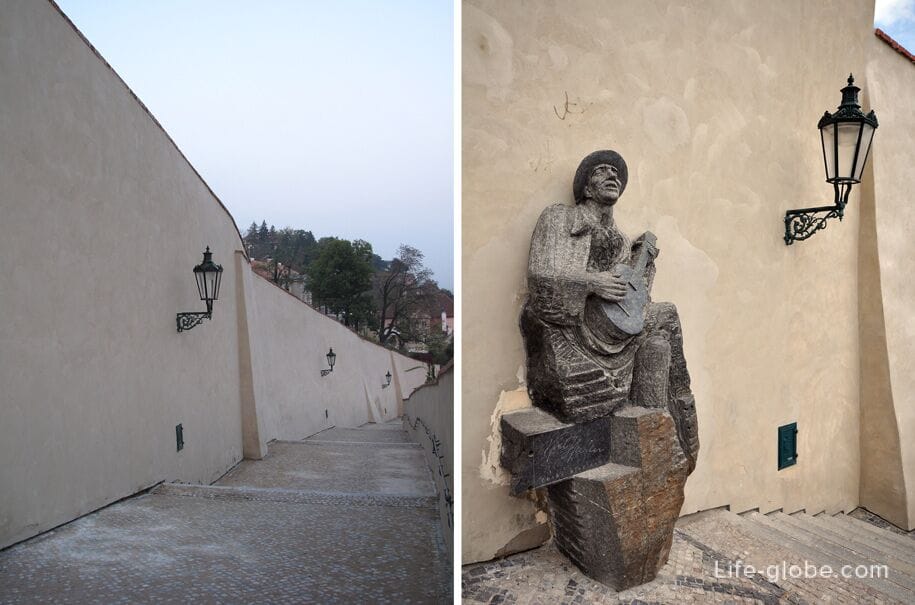
Remark! In addition to the Old Castle Staircase, the Prague Castle complex also has a so-calledA new castle staircase (Nové zámecké schody), which, in fact, is older than the old one and was created on the site of an old and steep roadway, registered since 1278 and known in the Middle Ages as a Steep Road.
This public pedestrian staircase connects Thunovská Street on Malaya Strana with the Castle Ramp on Hradcana Square.
Panoramic views of Prague open from the top of the stairs.

Prague Castle Gardens (+ fourth courtyard of Prague Castle)
Prague Castle is surrounded by gardens that were previously part of the castle.
By location, the gardens can be divided into southern, eastern, northern and western.
Southern Gardens of Prague Castle
The southern gardens were erected over time on the site of the southern fortifications of Prague Castle.
Today, the gardens have been given the look of the 1920s, when they were remodeled for President T.G. Masaryk by Slovenian architect Josip Plechnik.
The southern gardens stretch along the southern border of the walls of Prague Castle and in the summer season they can be accessed through the eastern gate or by a Bull ladder from the third courtyard of Prague Castle. The western entrance from Hradcana Square serves only as an exit.
The terraces of the southern gardens offer panoramic views of Prague.
The Southern Gardens complex consists of three gardens:
- The Garden of Eden or Garden of Eden (Rajská zahrada), located on the site of the oldest garden of Archduke Ferdinand of the 1650s. Rudolf II also had his own garden here. The imperial bathhouse and aviary were located in the garden.
The dominant feature of the garden is a monumental staircase or a large granite bowl in the middle of the lawn;
- garden on the Walls or garden on the Ramparts (Zahrada Na Valech), the name of which is associated with the original wall of fortifications on the south side of the castle, where the first small gardens began to appear later. The gardens underwent landscaping in the 19th century. In 1849, the gardens were surrounded by a wall, which was significantly reduced in the 1920s.
The central terrace of the garden offers a breathtaking view of Prague. At the end of the garden is the so-called Moravian Bastion (Moravská bašta), a corner with a view where T.G. Masaryk liked to sit;
- The Hartigovská zahrada Garden with a Music Pavilion is the smallest of the gardens on the south side of Prague Castle.
The garden was added before the 1960s. The garden acquired its current form in 1965, designed by architects Adolf Bensch and Richard Underground.

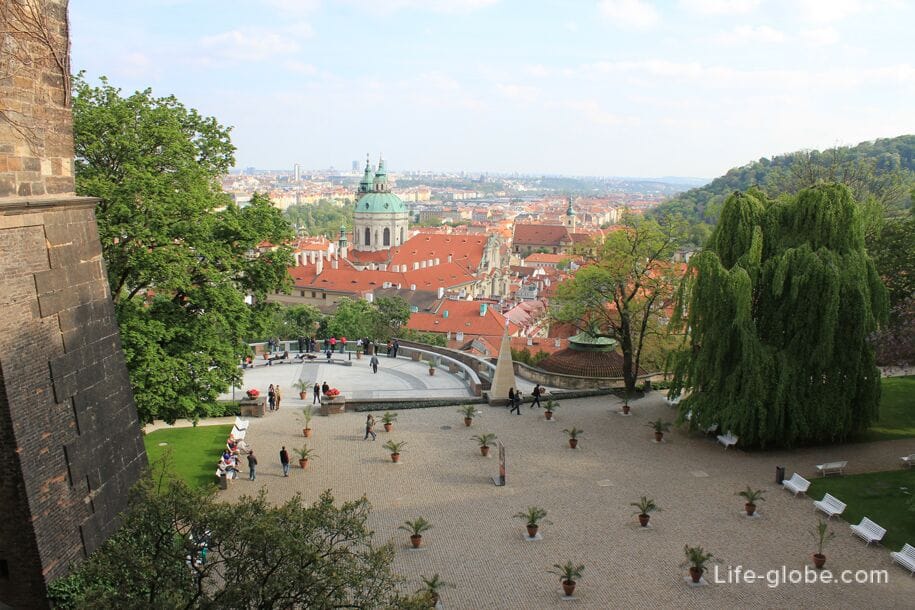
Southern Gardens under Prague Castle
To the east of the southern gardens, on the southern slopes under the Prague Castle there are interconnected gardens: Ledeburg, Palfi, Furstenberg and Kolovratny (Ledeburská, Pálffyovská, Fürstenberská, Kolowratská).
These gardens are part of the so-called palace gardens under Prague Castle and are a complex.
These are Baroque terraced gardens built on the site of former vineyards, or Renaissance gardens spread out next to aristocratic palaces.
The gardens have rich architectural decoration, decorative stairs, balustrades, observation decks, gloriettes and pavilions, united by vegetation into picturesque units.
Concerts, theatrical productions and various social events take place in the gardens.
The gardens offer picturesque views of Prague.

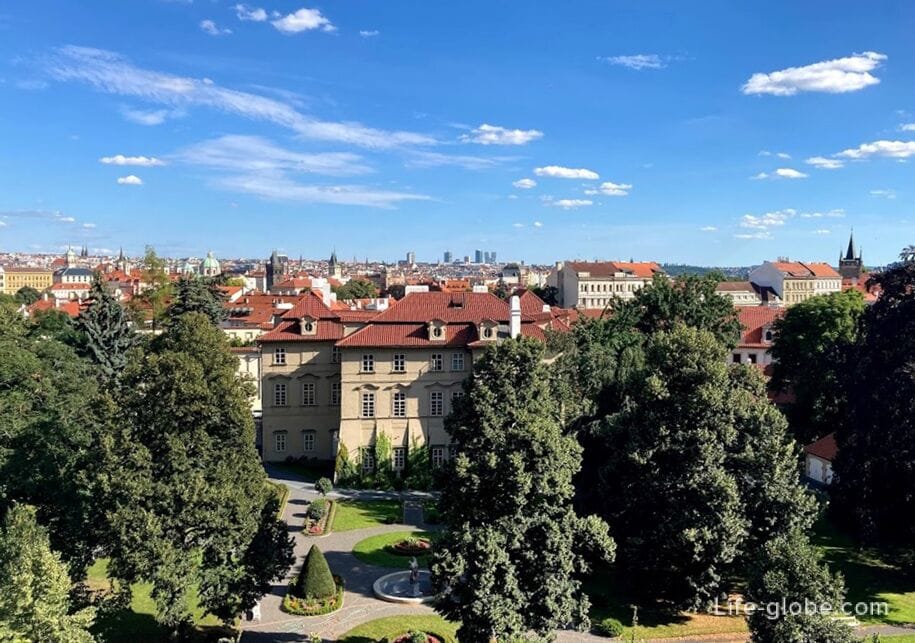
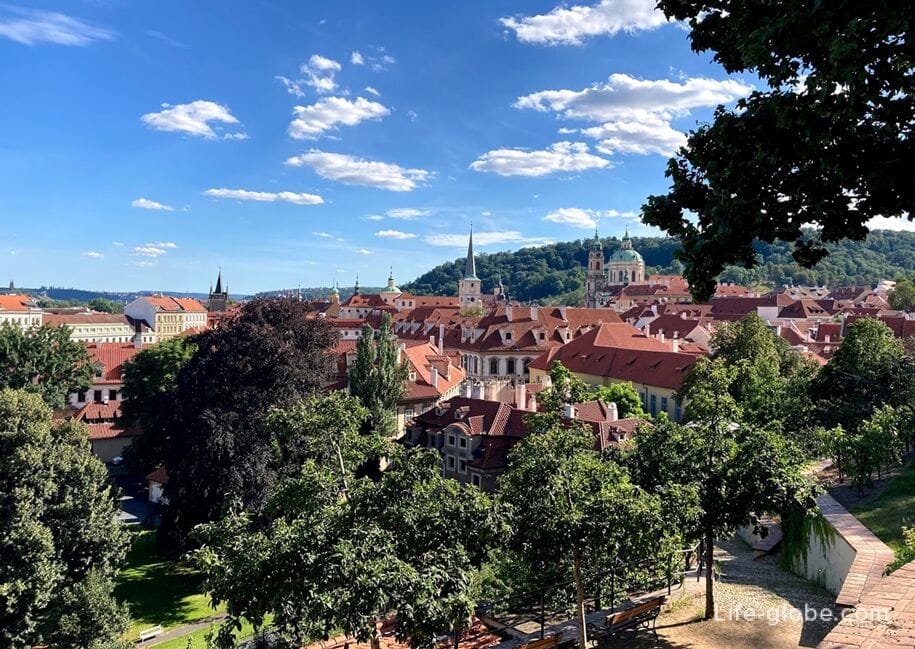
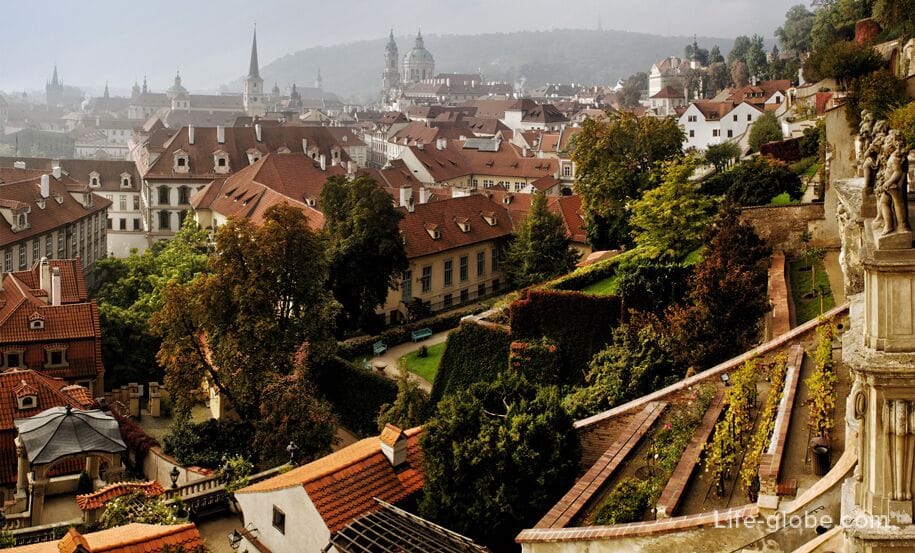
The Eastern Garden of Prague Castle
On the east side of Prague Castle, between the Old Castle Staircase and Na Opysi Street, there is the vineyard of St. Wenceslas (Svatováclavská vinice), which was officially opened to the public in September 2008, after reconstruction.
According to legend, this is the oldest vineyard in the Czech Republic, where the patron saint of the Czech land, Prince Vaclav, cultivated the "Lord's Vineyard".
The dominant feature of the vineyard is Richter's villa (Richterova vila), made in a classic style and where a restaurant is now located and various events are held: holidays, shows, weddings, banquets, etc.
The website of Villa Rihrerova: prazskyvinohrad.cz.
The vineyard offers panoramic views of a part of Prague.


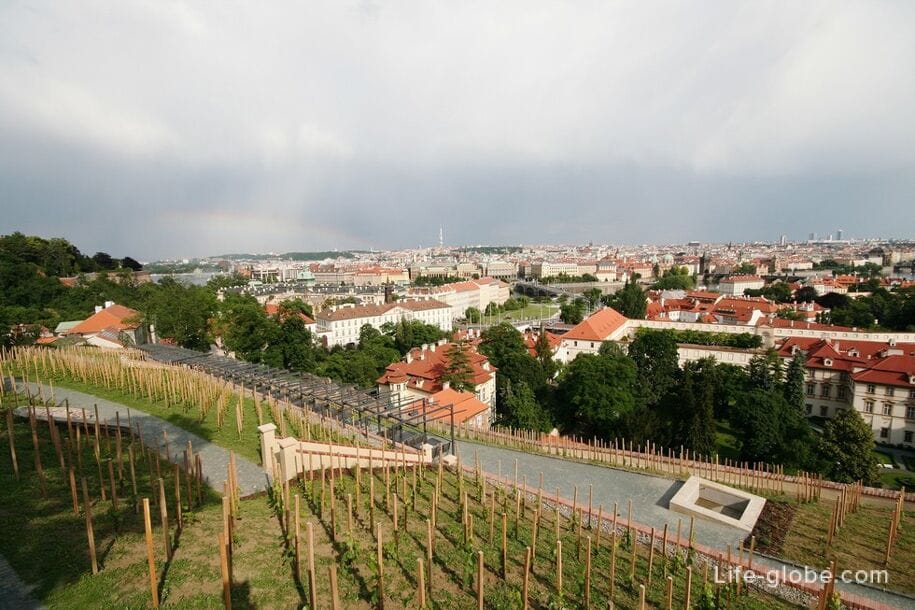
Northern Gardens of Prague Castle
The northern gardens of Prague Castle stretch along the northern part of the castle.
The most famous northern garden is the largeThe Royal Garden (Královská zahrada), which was created on the site of medieval vineyards.
The Royal Garden was founded in 1534 by Ferdinand I of Habsburg, who gradually bought old vineyards from the owners and laid out a Renaissance garden, later famous for its botanical rarities and exotic plants from distant countries. The garden was complemented by a number of buildings serving for the entertainment of the courtiers. So the Ballroom, the Royal Summer Palace and the Lion Court were created.
The current appearance of the Royal Garden repeats the natural, so-called English composition of the mid-19th century, but also contains elements of Renaissance and Baroque layout.
In the summer season, the garden can be accessed through three entrances: two western entrances from the street near the Prashny Bridge and through the northern gate of the Royal Summer Palace.
The most attractive building in the garden is the Summer Palace of Queen Anne (Letohrádek královny Anny) in the Renaissance style, which was built in 1538-1560 for the wife of Ferdinand I Anna Jagiellonian. Today, the Royal Summer Palace is used for exhibitions of fine arts and crafts.
Also in the garden stands out the Renaissance Ballroom (Míčovna), built between 1567 and 1569 and served for ball games, and later as a military warehouse. Today the hall is used mainly for art exhibitions, concerts and social events.
The palace and the hall are open only during exhibitions. The entrance fee varies depending on the type and scale of the exhibition.
In the northern part of the Royal Garden, the so-called Empire Greenhouse (Empírový skleník), founded around 1820, adjoins the original Renaissance wall. Also in the garden there is a Modern Greenhouse (Moderní Oranžerie), built on the site of an old greenhouse of the 1950s on the initiative of Olga Havel. During the summer months, guests have the opportunity to visit greenhouses and admire heat-loving plants.
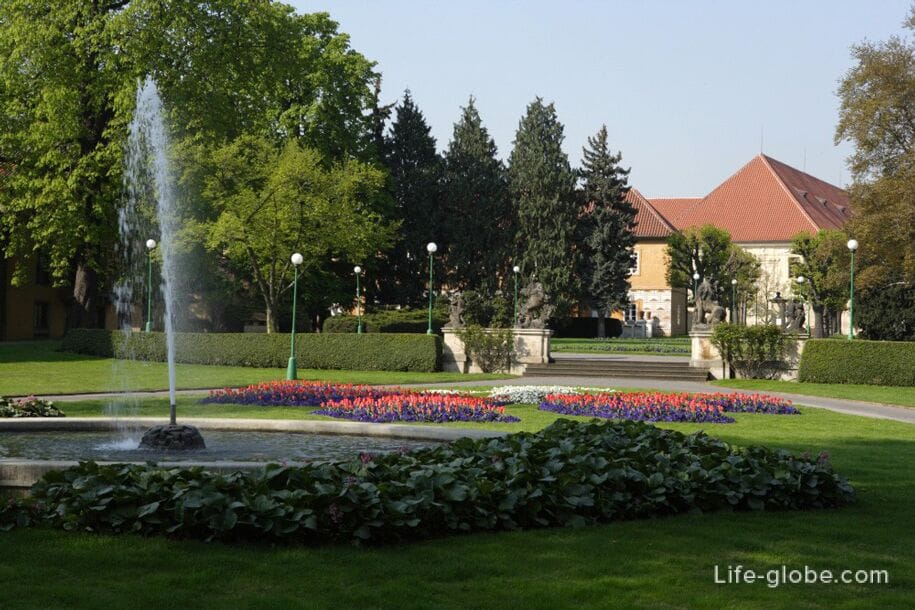
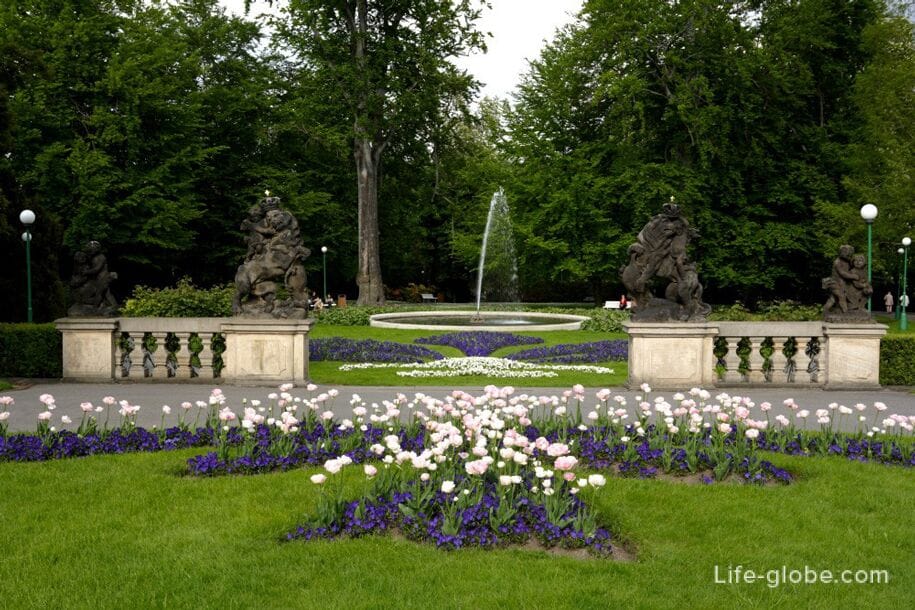

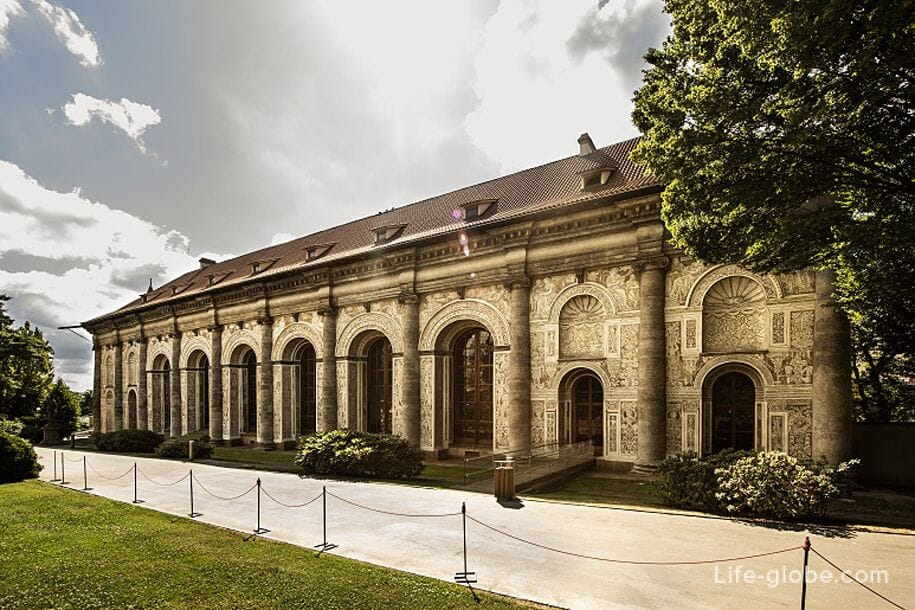
The terraces of the riding school or riding arena (Jízdárna Pražského hradu), laid out in 1950-1956 on the site of the originally open summer riding school.
The terraces offer interesting views of St. Vitus Cathedral and part of the northern fortifications of Prague Castle. The gardens are sometimes used for concerts or other events.
The building of the riding school has a facade in the Baroque style of the late 17th century. Since the middle of the 20th century, the riding school has provided premises for exhibition purposes.

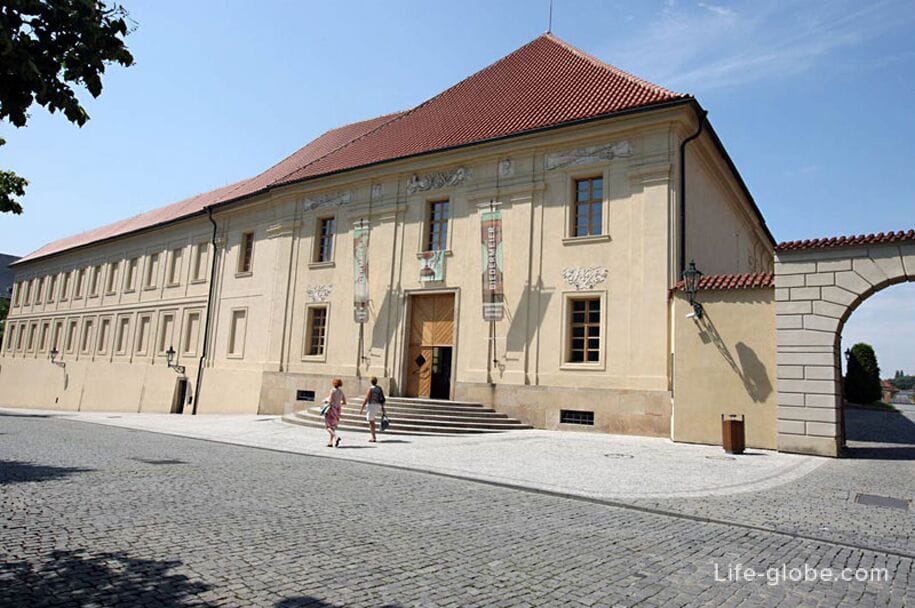
Opposite the Prague Castle Arena there is a small building with a wooden porch in the courtyard - this is the house of a falconer (D?M sokolníka), which houses an exposition telling about the life of its first resident, who in the 17th century was a falconer who took care of hunting with birds of prey.
The house has: a furnished study and a bedroom, and you can also watch a short film about falconry. In the study, you can see falconry utensils, for example, gloves, a satchel, special seats or caps. Hunting weapons such as crossbows, bows or spears are placed in the bedroom. In the projection room on the ground floor, it is worth paying attention to the restored ceiling beams of 1600 and 1601.
Entrance to the Sokolnik's house is paid. Tickets can be purchased at the ticket offices of the information center in the third courtyard of Prague Castle.
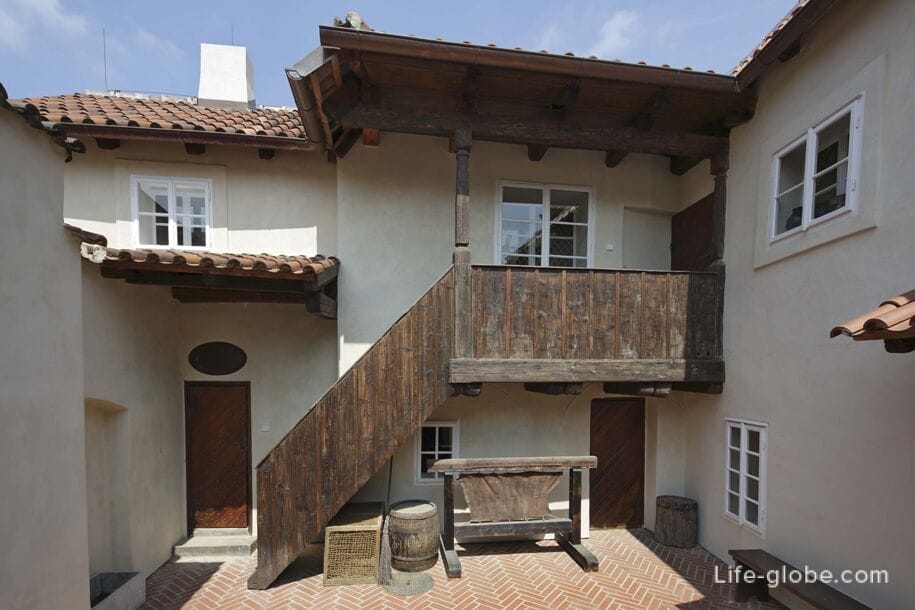

To the west of the arena of Prague Castle is the Lumbe Garden or Lumbeho zahrada, which is named after Karl Lumbe, a famous surgeon, the former owner of this land.
In the garden there is an observation deck of Masaryk (Masarykova vyhlídka), and the garden itself is used by the administration of Prague Castle.
Deer moat (Jelení příkop), which is a natural gorge and is located near the northern walls of Prague Castle in the place where the brook Brusnice flows.
Game could be found in the gorge up to the 18th century. This tradition was symbolically followed by the period of the First Republic, when a bear pen was built in the upper part of the moat. In the period from 2001 to 2002, a connecting tunnel was laid through the embankment, dividing the moat into upper and lower parts according to the Ya project. Pleskota.
The Deer Moat is open to the public free of charge during the summer season.
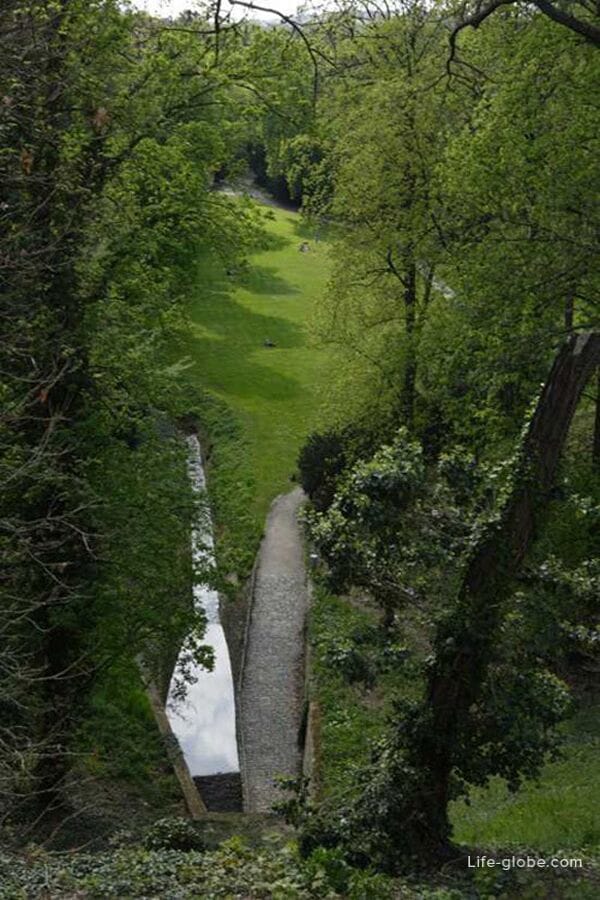
The Western Garden and the fourth courtyard of Prague Castle
On the western outskirts of Prague Castle there is a garden On the Bastion (Zahrada Na Baště), the current form of which dates back to the 20th century - this is the work of Slovenian architect Josip Plechnik in the style of Italian and Japanese gardens.
The name of the garden recalls the remains of an older medieval fortification discovered here. Access to the garden is possible from the Powder Bridge (Prašný most), thrown over the Deer Moat at the northern wing of Prague Castle.
The Powder Bridge leads to the North Gate of Prague Castle, which, in turn, leads to the second courtyard of Prague Castle.
The Bastion Garden occupies most of the fourth courtyard of Prague Castle (Čtvrté nádvoří Pražského hradu).
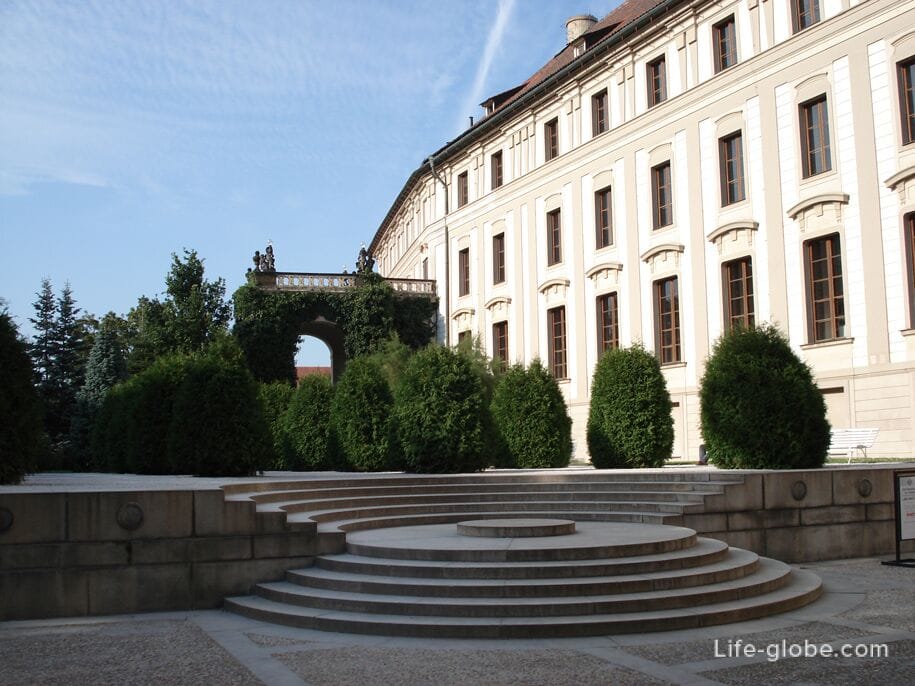
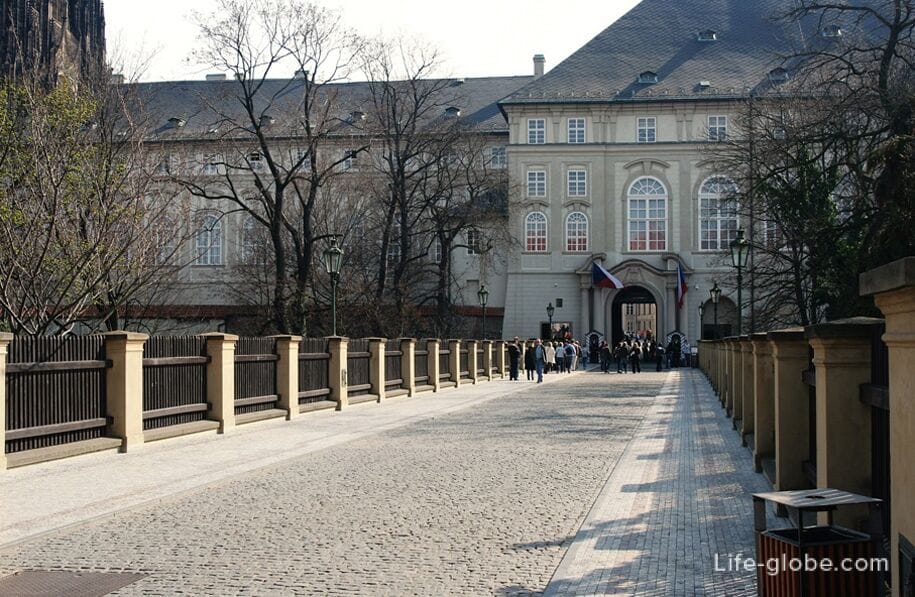
Map of Prague Castle facilities
1. Hradčanska Square (Hradčanské náměstí)
2. Gate of Giants (Brána gigant?)
3. The first courtyard (První nádvoří)
4. Matyas Gate (Matyášova brána)
5. The second courtyard (Druhé nádvoří)
6. The third courtyard (Tretí nádvoří)
7. St. George's Square (Náměstí U Svatého Jiří)
8. Yirzhska / Georgievskaya Street (Ulice Jiřská)
9. The Eastern Gate (Východní brána)
10. The old castle staircase (Staré zámecké schody)
11. Garden On The Ramparts (Zahrada Na Valech)
12. The Garden of Eden (Rajská zahrada)
13. The new Castle Staircase (Nové zámecké schody)
14. The Garden on the bastion and the fourth courtyard of Prague Castle (zahrada Na Baště, Čtvrté nádvoří)
15. Powder Bridge (Prašný most)
16. Deer moat (Jelení příkop)
17. Opys hill on which the Prague Castle stands (Opyš)
18. Vikarska Street (Vikářská)
19. Kohlov fountain (Kohlova kašna)
20. The Well (Studna)
21. Obelisk (Monolit Mrákotínský)
22. Monument to St. George (Socha svatého Jiří)
23. Chapel of the Holy Cross (Kaple svatého Kříže)
24. Column Hall (Sloupova sín), part of the executive premises
25. Prague Castle Art Gallery (Obrazárna Pražského hradu)
26. Spanish Hall (Španělský sál), part of the executive rooms
27. Imperial Stables (Císařská konírna)
28. Entrance to the President's apartment (Příjezd k bytu prezidenta), part of the executive premises
29. Cathedral of St. Vitus, Wenceslas and Vojtech (Katedrála svatého Víta, Václava a Vojtěcha)
30. Excavations (Prúhled do vykopávek)
31. The old house of the Vice-rector (Staré proboštství)
32. Foundry yard on Vikarka Street (Na Vikárce a Slévárenský dvūr)
33. Migulka Tower (Prašná věž Mihulka)
34. Eagle Fountain (Orlí kašna)
35. Bull Ladder (Býčí schodiště)
36. The Office of the President of the Republic and the apartment (Kancelář prezidenta republiky)
37. The Old Royal Palace (Starý královský palác)
38. The Horsemen's Ladder (Jezdecké schodiště) in the Old Royal Palace
39. Vladislavsky Hall (Vladislavsky sál) in the Old Royal Palace
40. The building of the Dean's Office of the Chapter (Kapitulní děkanství)
41. The New probost House (Nové proboštství)
42. Basilica of St. George / Jiří (Bazilika svatého Jiří)
43. Rožmbersky Palace - Institute of Noble Maidens (Rožmbersky palac - Ústav šlechtičen)
44. Church of All Saints (Kostel Všech svatých) in the Old Royal Palace
45. Zolotaya ulochka (Zlatá ulička)
46. The Old Burgraviate (Staré purkrabství)
47. Lobkovitsky Palace Museum (Lobkovický palác)
48. Monastery of St. George (Klášter svatého Jiří)
49. The White Tower (Bílá věž)
50. Daliborka Tower (Daliborka)
51. The Black Tower and the Eastern Gate (Černá věž).
Entrance and tickets to Prague Castle
The entrance to the Prague Castle complex is free.
Visiting the objects of Prague Castle: palaces, St. George's Basilica, parts of St. Vitus Cathedral, Golden Lane with White Tower and Daliborg Tower, Institute of Noble Maidens, Powder and Black Towers - paid.
There are several types of complex tickets. Also, some objects of the Prague Castle and temporary exhibitions can be visited with separate tickets.
A visit to the observation deck of St. Vitus Cathedral is paid separately.
In the evening (in winter after 16:00, and in summer after 17:00), the entrance to the Golden Lane becomes free, but by this time the exhibition houses on the street and most souvenir shops are already closed, but you can walk along the street and visit, also for free, the exposition of knight's armor, weapons and instruments of torture.
The representative rooms of the New Royal Palace can only be visited on open days.
Entrances to the southern gardens of Prague Castle and the southern gardens under Prague Castle are paid.
Palaces and rooms in the northern gardens can be visited for a fee during exhibitions. Permanent exhibition in the Sokolnik house - paid separately.
An audio guide can be rented in Prague Castle.
During the year, various temporary exhibitions and events, holidays and festivals take place on the territory of Prague Castle, including a Christmas market and a mini-brewery festival.
We recommend you to check all the conditions for visiting Prague Castle facilities, expositions, exhibitions and events, places of purchase of tickets and the cost of tickets on the official website of Prague Castle: prazsky-hrad-pro-navstevniky.
Lobkovitsky Palace is a separate private museum. Entrance is paid. Website of the Lobkowitz Palace Museum: lobkowiczky-palac.
In Prague Castle there is a toy Museum (Toy Museum Prague), displaying four centuries of toy development. Museum exhibits: trains, cars, airplanes, bears, dolls, kitchens, wooden toys, zoos, Barbies, Star Wars, robots, etc. This is a private collection of toys by Ivan Steiger. The museum's website: toymuseumprague.com .
Address and how to get to Prague Castle
Address of Prague Castle: Hradčany, 119 08 Prague 1, Czech Republic.
Coordinates of Prague Castle: 50°05'26.0"N 14°23'59.0"E (50.090556, 14.399722).
You can get to Prague Castle by public transport, taxi, car or on foot from the historical center of Prague.
To get to Prague Castle by public transport, tourists most often use the tram stop "Prague Castle", which is near the Royal Garden (option 1 below) or the stop "Pohořelec", which is near Hradcany Square (option 2 below). After visiting Prague Castle, you can go down the Old Castle Stairs to the metro station "Malostranska" line A (option 4 below).
The scheme of stops near Prague Castle
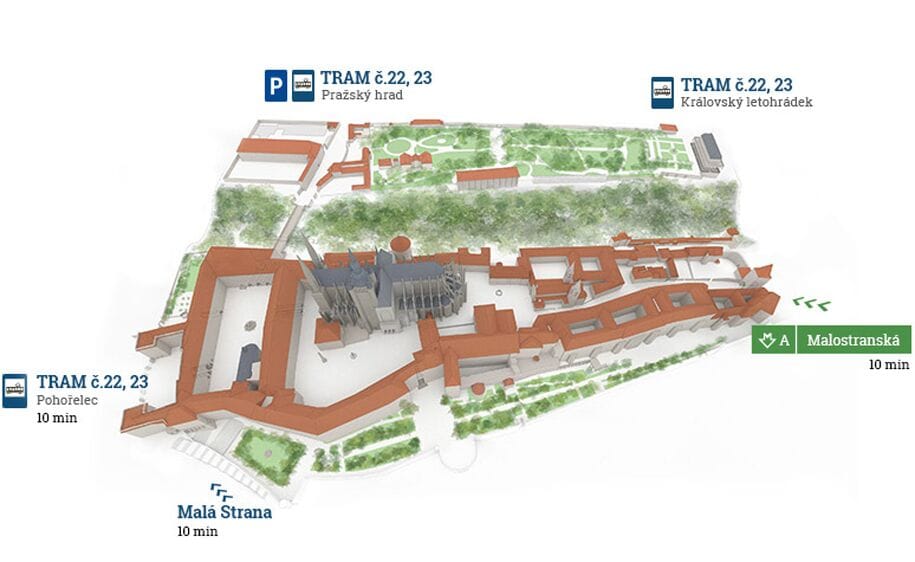
Option 1
Take trams No. 22 or 23 to the Prague Castle stop (Pražský hrad), then turn left and walk along U Prašného mostu Street, then cross the Powder Bridge and enter the second courtyard of Prague Castle through the Northern Gate.

Option 2
Take tram No. 22 or 23 to the Pohořelec stop, then go down Loretánská Street and exit to Hradcany Square, then cross the square and find yourself at the main gate of Prague Castle - the gate of Giants, behind which is the 1st courtyard of Prague Castle.
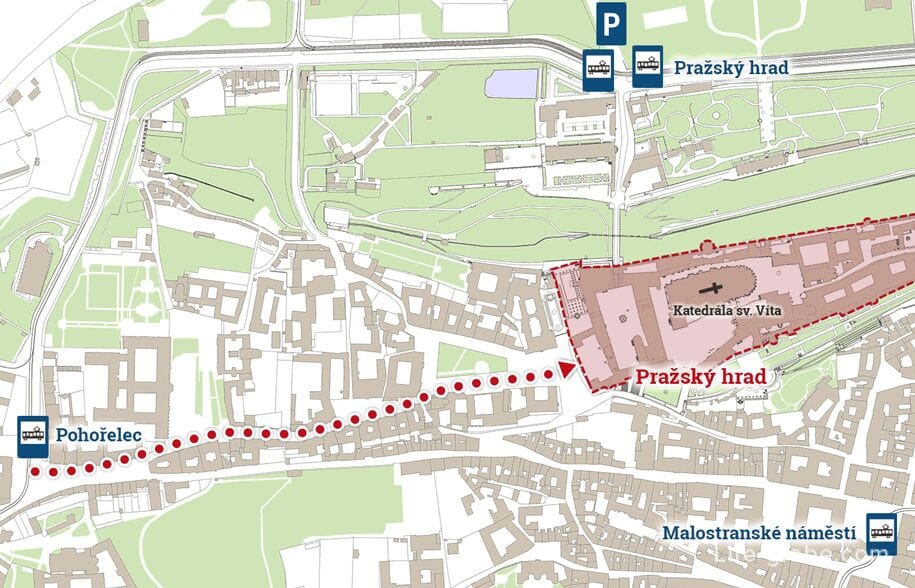
Option 3
Take tram number 22 or 23 to the stop "Malostranské namesti" (Malostranské náměstí). After that, you need to go to Zámecká Street, then turn left onto Thunovská Street, which will lead you to the New Castle Staircase, climbing which you will exit to Hradcany Square, and from there to the Gate of Giants in Prague Castle.
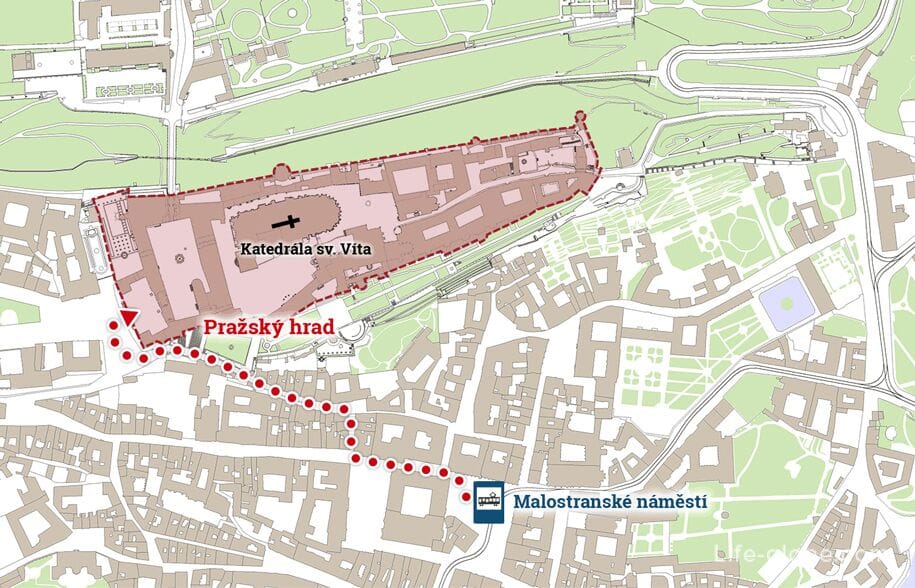
Option 4
Take the metro line A (green line) to the station "Malostranská" (Malostranská). Then walk about 100 meters along the tram line and turn left onto the Old Castle Staircase, which leads up to the Eastern Gate and the Black Tower of Prague Castle.
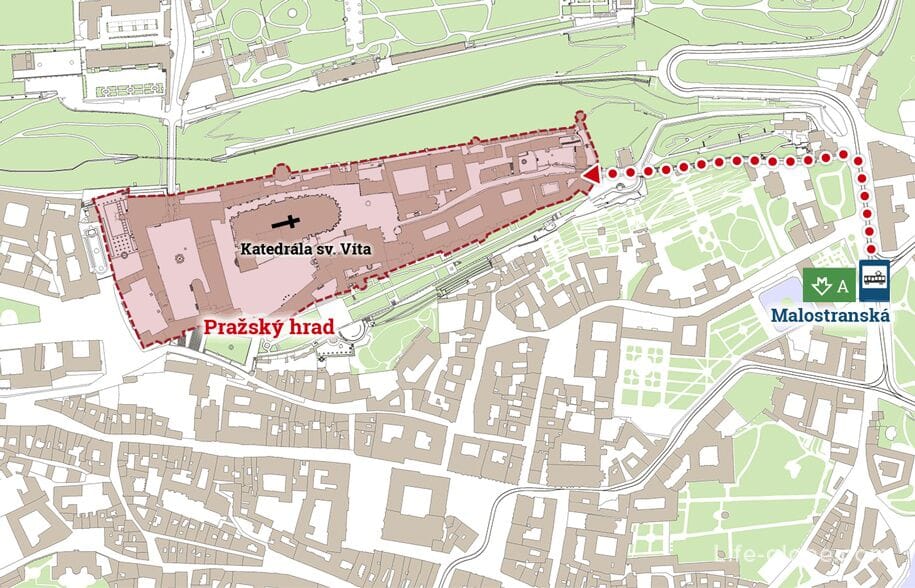
Option 5
Take tram No. 22 or 23 to the stop "Královský letohrádek" and enter the Royal Garden, walking along which, in about 15-20 minutes, you will pass opposite the Prague Castle Arena. Then, across the Powder Bridge and through the Northern Gate, enter the second courtyard of the Prague Castle.
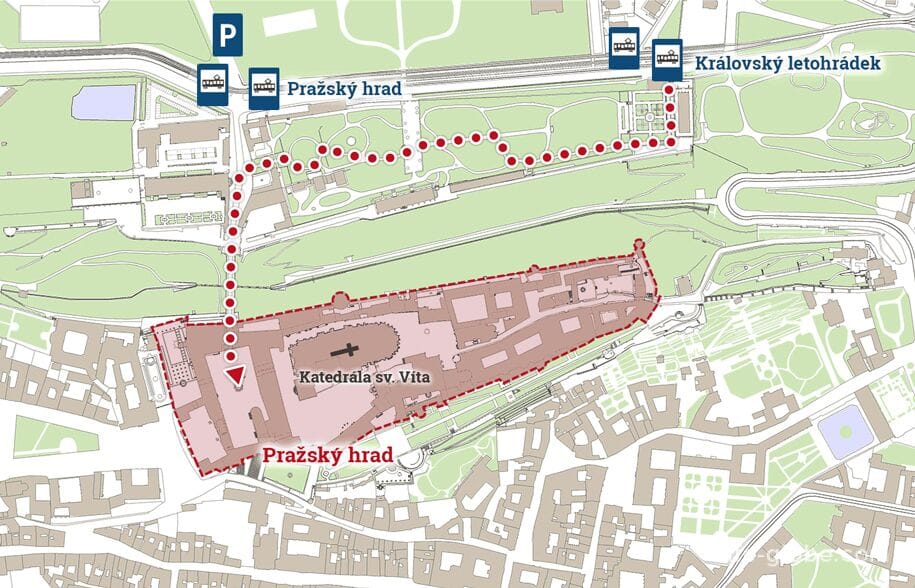
All accommodation facilities in Prague (hotels, apartments, guest houses, etc.), including near Prague Castle, in the historical center of the city and more remotely from those, can be viewed and booked here




